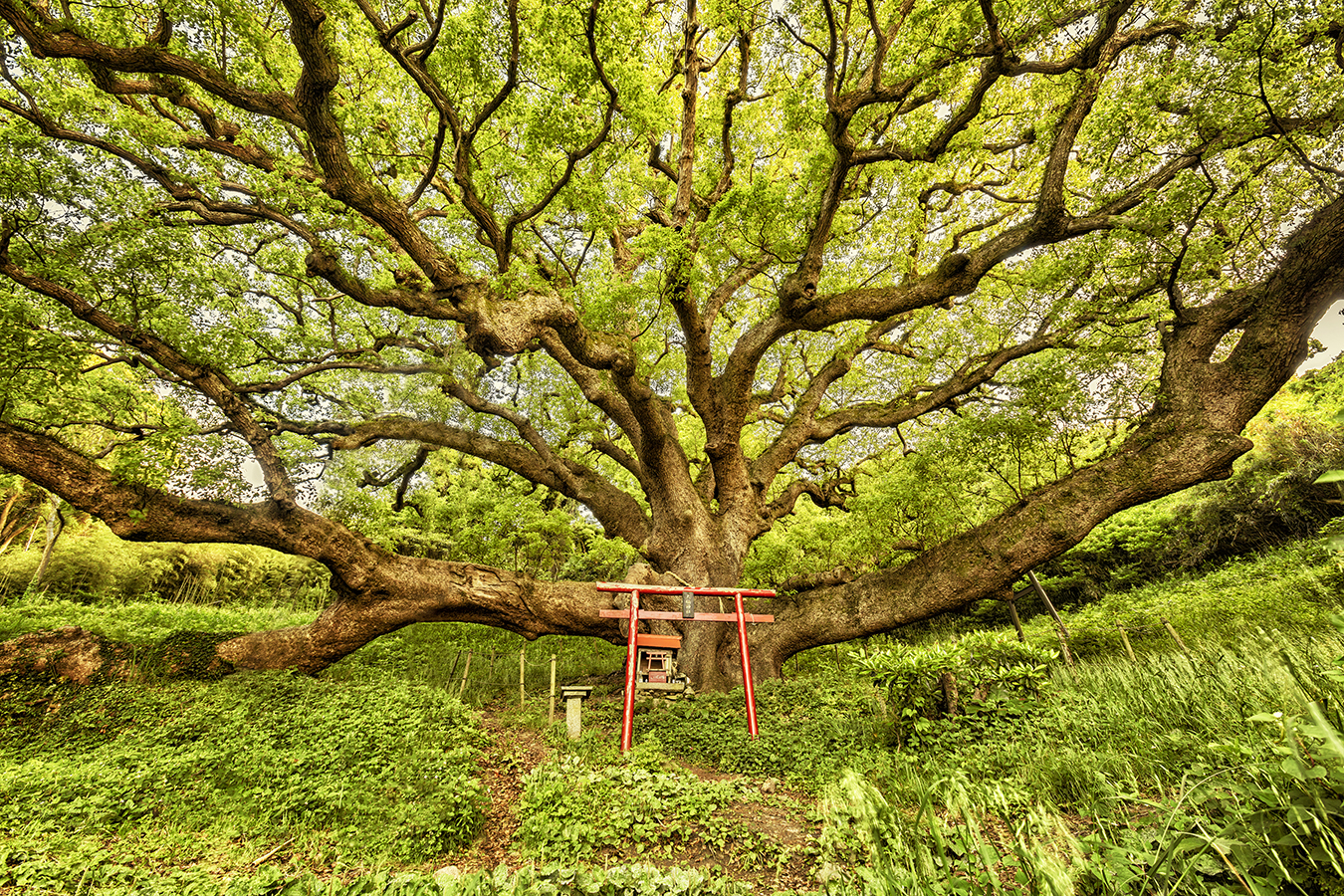
As the self-portrait photographer and arborist TreeGirl, I have spent hours of intimate time with hundreds of trees—some of the most ancient and largest individuals on the planet. My fascination with trees is equally ecological, sensory, and spiritual, but I mostly depend on my intuitive senses to guide me. I seek these trees out like a treasure hunt because I want to experience the wisdom and energy of these wise elders that cannot be somatically and sensorially understood from a photograph alone. In my practice, I listen to each ‘spirit of the tree’ energetically and psychically. If I feel inspired, and it feels safe and right to do so, I respectfully climb the tree, finding the places where I ‘fit”, as a form of somatic ecotherapy and meditation. I have captured beautiful, and sometimes energetically ecstatic, private moments on film (using a remote control) of myself in the nude intertwined with these trees. My intention in documenting these experiences is both aesthetic in the genre of classic beauty, and to show that as humans, there is no separation between us and nature. My aim is to invite intimacy with the wild, as a way to ‘rebond’ with wild nature, that from which we as a modern, industrialized culture in crisis has become alienated and disassociated.
I have traveled all over the world in my search for these trees, which has inadvertently led to an ecopsychological study of the human-tree relationship. Each region in the world is different. On a month-long tree- and forest-therapy research expedition in Japan in Spring of 2019, I made pilgrimages to sacred trees known as shinboku (or goshinboku)—trees that are revered as sacred dwelling places, shrines for kami [1]— Shintō deities or spirits. I was very curious to meet them and understand more about the dynamic between Shintōism and trees; what makes these particular ancient trees so culturally an spiritually significant? Shinboku are especially large, old, or notably magnificent to anyone who is in their presence. In my experience, the presence, power, and energy—and I would say “holiness”— that these trees radiate go way beyond anything I had previously encountered in my twenty-five career. So much so, that I was confused about what, or who, was so powerful: was it the tree itself, the ‘spirit’ of the tree, or the kami who I was experiencing? This kind of mysterious encounter with more-than-human beings experienced through sensory perception, is what I term “phenomenality”.
Here I share with you five stories of my encounters with five phenomenal trees ‘who’ unexpectedly and forever changed the way I understood trees. I will preface by saying that as a Westerner, my understanding of Shintō is limited based my brief thirty-day experience visiting Japan. Shintō is sometimes referred to as an “intuitive religion” (“chokkan shukyō”), the essence of which can only be grasped experientially (and supposedly not completely understandable by Westerners.[2]) Therefore, I will focus on my own personal experience as an animist, an arborist specializing in ancient trees, TreeGirl the photographer, and my inquiry based upon my own literary research. But first, I offer some fundamentals about Shintō as a spiritual system and trees in Japanese culture.
Trees of Japan
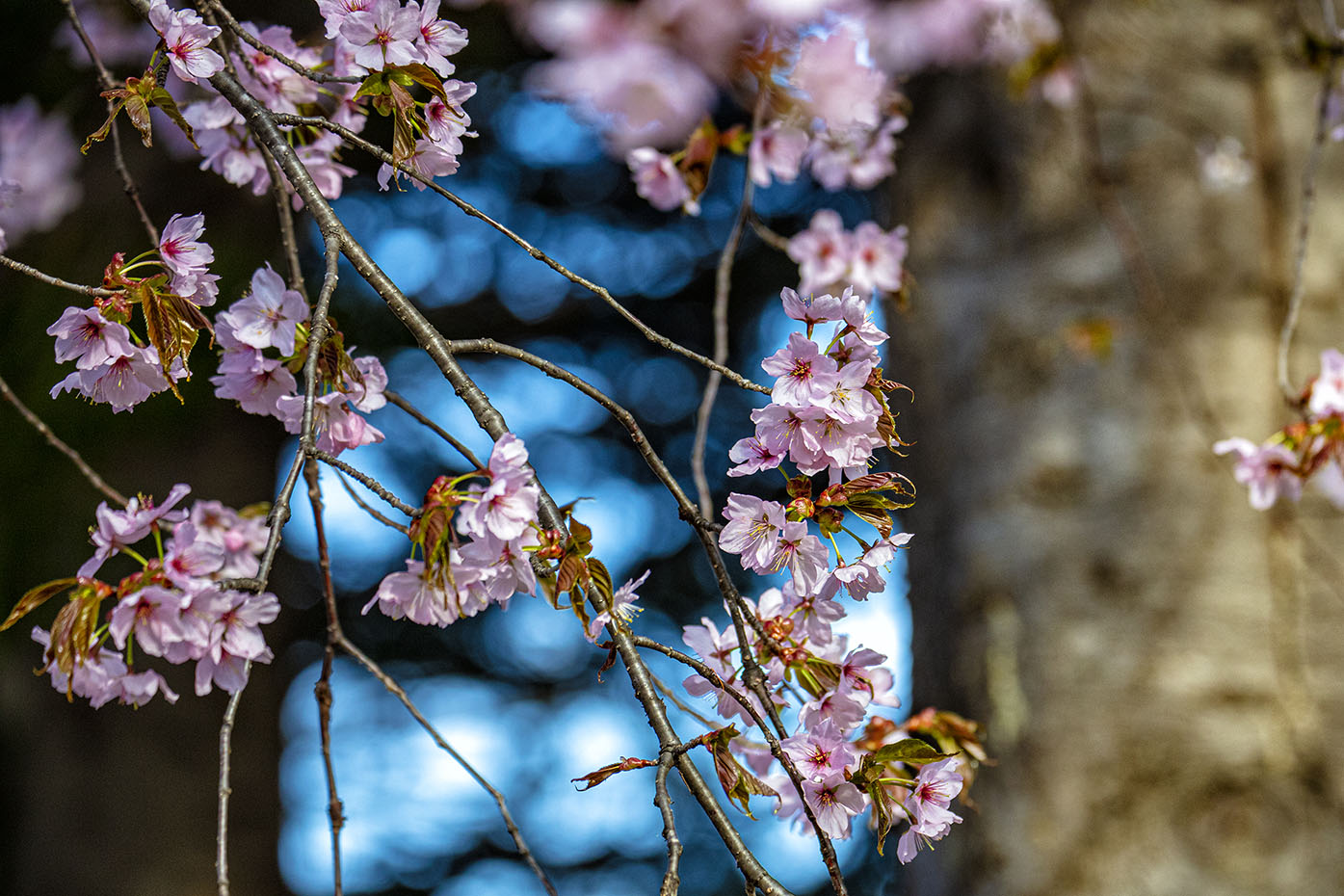
The Japanese culture is well known for its appreciation of the aesthetics of trees, especially during the riot of Spring blossoms (hanami) like the cherry, or sakura (Prunus sp.) trees and the flush of warm Autumn colors such as Maples and the non-native Ginkgos. As well, the Japanese are known for their formal, manicured gardens and specific horticultural techniques, including bonsai (which some, this author included, consider to be a form of horti-torture). Finely sculpted Pine trees (matsu), in the tradition of niwaki, have especially historically been a significant theme and symbols of many Japanese arts. The Japanese certainly love their trees, both domesticated and wild.

Most people do not think of forests when they think of Japan, but currently over 60% of the land in Japan is beautifully forested. Most of these forests are second- and third-growth forests, since the country was almost completely deforested in the 1600s. Today, silvaculture practices take place mainly in plantation forests and any tree cutting must adhere to a strict ritual protocol involving a Shintō priest. There are over a thousand native species of trees in Japan. The genera of trees living in Japan are similar to common ones you’d find at the same northern latitude in temperate ecosystems around the world, while their species vary by region: conifers such as Pine (Pinus sp.), Fir (Abies sp.), Cypress (Cupressus sp.), Larch (Larix sp.), Spruce (Picea sp.), and broadleaf trees such as Oak (Quercus sp.), Willow (Salix sp.), Ash (Fraxinus), Linden (Tilia sp.), Birch (Betula sp.), Alder (Alnus sp.), Maple (Acer sp.), Chestnut (Castanea sp.), and Dogwood (Cornus sp.). Common to island biogeography, there are also many species endemic to specific regions in Japan. Some of the most dominant native forest tree species is the Japanese Red Cedar “Sugi” (Cryptomeria japonica). This abundant mix of tree species, some familiar and some new, made this expedition especially exciting for the tree nerd in me.
Shintōism
Shintō is the indigenous, animistic spiritual system of Japan (sometimes referred by scholars as the “ethnic religion” or minzuku shūkyō), dating back to when the islands were first inhabited by humans over 30,000 years ago. Buddhism did not arrive until it was imported from China around 600 AD, after which it slowly hybridized with Shintō over a span of 1,200 years to become the Japanese culture we know today. Shintō has no theology, and is founded in nature-based animism, shamanism, polytheism, pantheism, and the veneration of ancestor spirits. Shintō equates to “the belief or faith in kami,” or “the path through which we seek to realize ourselves fully as human beings by acquiring the noble character of kami.” Some kami (plural: kamigami) are creator deities, some are nature deities, and some are ancestors, or mortals who have been deified—deemed to have obtained spiritual status (similar to Catholic sainthood, however, their power is based on their power, not on their deeds). The kami are rarely iconographized in art (as opposed to many religions), with the exception of paintings of some creator gods or statues of historical ancestors, such as emperors.
Kami are everywhere. There are literally millions of kami, and they are said to only exist in Japan; employing ecological terminology, Shintō is bioregionally endemic to the islands of Japan since it is intimately connected to the physical landscape, traditions and imperial family (whereas Buddhism, as a ‘world religion’ is clearly not). However, Shinto has become more internationally popular as a “nature religion”. Kami, who may be male or female, exist in our world formless and invisible. However, not all kami are divine and some are malevolent. Nature kami may naturally reside in earthly vessels, such as trees, rocks, caves, volcanoes, mountains, waterfalls, and streams, or exist as natural phenomena such as rain, fire, or earthquakes.
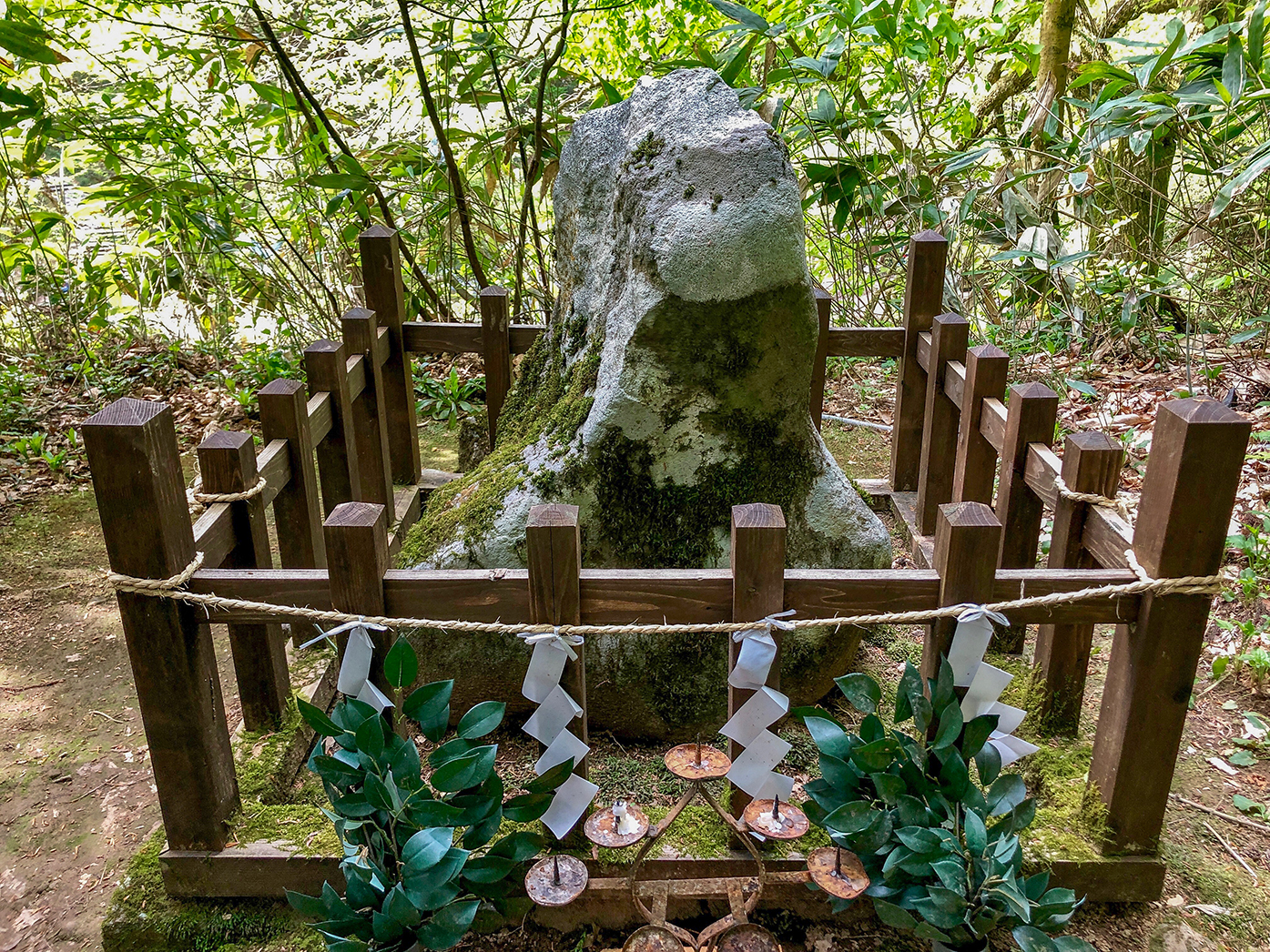
A goddess kami enshrined in a large rock at Mt. Hagaro Shrine Complex. Note the sakiki tree leaves and shimenawa rope indicating something sacred.
At the same time, kami may manifest spontaneously in humanoid or zoomorphic forms, or as spirit animals.[3] As in the legend and Nōh play of Takasago Pines, kami may shapeshift between human form, physical tree form, and mystical kami form and, as well, are able to bi-locate. How do we know they are there? Indeed, as the legend poetically says, “The sound of the wind in the trees is the sound (the song or poetry) of the kami communicating with one another.”[4] So, next time you see or hear wind blowing in the trees, you may ask yourself who is doing the blowing and what is the message?
In Japan, kami may be invited to descend into a shrine (jinja)–which may be a tree– or a specific object (shintai) by a Shintō priest. Shrines are public places of worshipping the kami (for making offerings and prayers), whereas thousands of years ago, people would simply pay honor to nature itself. Kamidana are miniature household altars for kami worship. Kami may not necessarily live at the shrine; but are politely summoned through specific protocol. According to Shintō, the kami come and go as they please, and can change where they descend and reside—even residing in multiple places at once. Indeed, there may be hundreds of shrines for just one kami.
The concept of kan’no means responding to nature as deity and feeling in awe of it in one’s mind (oneness). When people feel the blessing of nature, they feel that they are at one with kami. The existence of kami, because they are mostly invisible, is based more than just on faith; it is a felt experience, perceivable through one’s ability to be sensitive to things of the phenomenal world. This Shintō paradigm of experiencing unity of humans and nature very much mirrors my work as TreeGirl in my intertwining with trees for the purpose of experiencing the lack of separation between human and nature.
This acknowledgement and reverence for honoring deities and spirits in natural formations and forces are common among animistic spiritualities around the world. There is much more complexity to the fascinating culture and arts of Shintōism, including its unique aesthetics, symbolism, traditions, rituals, regalia, ceremonies and festivals, divination, protocol, architecture and even modern politics, but for now, I will focus on aspects of trees in particular, some of whom are shrines unto themselves.
The Spiritual Dimension of Trees
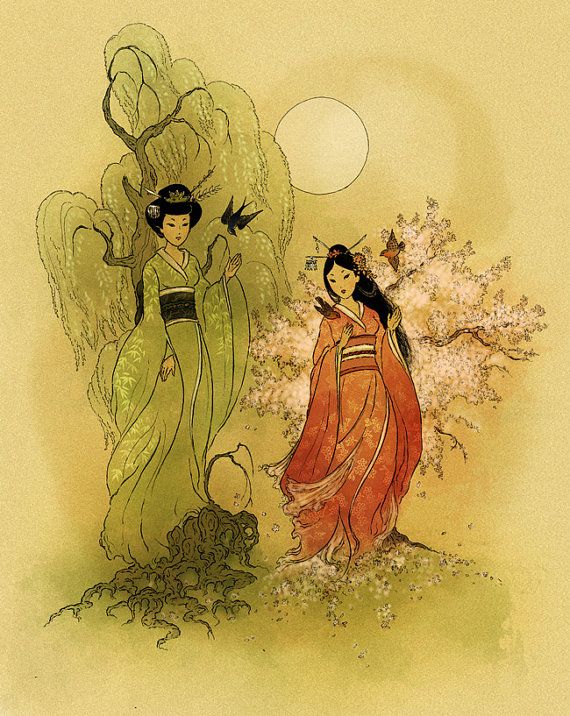
Trees are an integral part of the traditional culture and sacred landscape of Japan, with their own spiritual dimension, connecting the world of the kami to the earth and to the people. In fact, trees are an important part of the creation myths of Japan:
“Indeed, the importance of these tree-dwelling kami was established in the Kojiki (Record of Ancient Matters), where the legend is told of the founding sibling gods of Japan Iznagi and Izanami. The two gave birth to hundreds of thousands of godling children, but their second-born was the kami of the trees.”[5]
Very early on culturally and ecologically, there was a distinction two types of forests: Satoyama, forests that people would use to gather basic needs and make a living from, and Okuyama, forests deep in the mountains where people do not enter. Okuyama was the place where the ancestors’ spirits and deities resided. Small shrines would be built at the edges of these forests.[6] Later, these became the larger shrines and shrine complexes that have survived today. As shrines were built to honor the kami of the forests, many shrines reserved areas of designated “sacred forests” (kannabi or chinju no mori). These forests continue to be sanctuaries, ecologically and spiritually. Some shrine complexes with multiple shrine buildings, cover a vast acreage of forested mountains. Some forests, such as the Akasawa National Recreation Forest (the birthplace of Forest Therapy) in the Nagano Prefecture, are not shrine forests, but designated for the growing and ritual cutting of the fragrant native Hinoki (Chamecyparis obtusa) trees for shrine buildings. In addition to the Hinoki, more than thirteen species of trees function as sacred in Shintō and Buddhist ritual, symbolism and architecture in Japan.
In Shintō, trees are sacralized in several ways:
Trees as spiritual antennas: In Japan, all trees are viewed as antennas to the spirit world. On the grounds of shrines, you will often find fenced-off areas called himorogi, with trees surrounded by paper fortunes. Prayers may also be tied directly onto a tree branch as transporters to the divine realm.
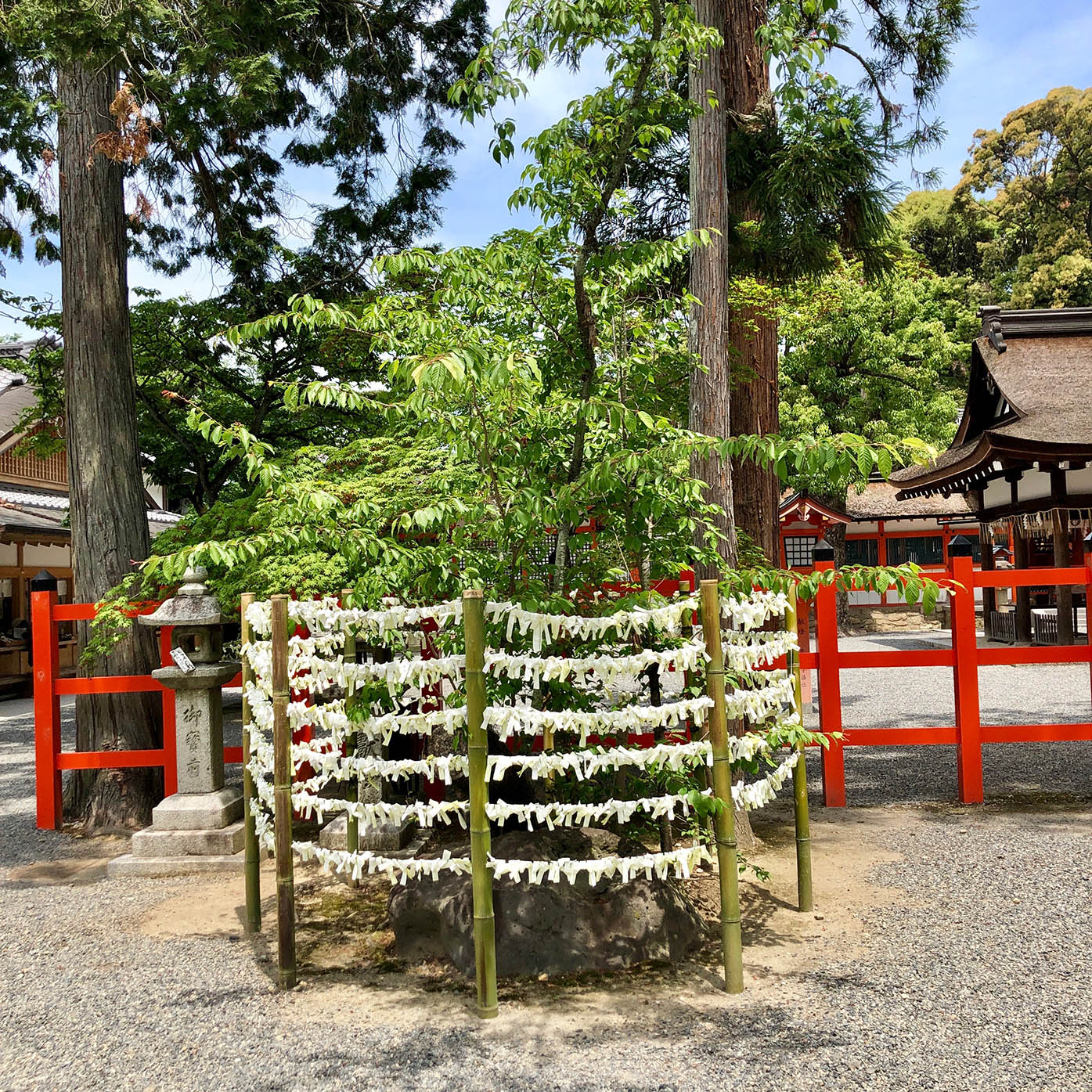
Trees as purification: In earlier times, if there was no water available at a shrine for purification, people used green leaves from trees to wipe and cleanse their hands, or used simple objects constructed from cypress or cedar tree bark.
Trees as offerings: Branches of the sakiki tree (Cleyera japonica), called tamagushi, are used on altars and in rituals as an offering to the kami.

Trees as metaphors for the soul: Each person’s spirit (and each kami) is said to be made up of four parts: form/wooden nature (aramitami); sap/resin (nigamitami); regenerative organs such as flowers and fruits (sachimatami); and the vitality of the tree’s growth expressing character (kushimitami).
Trees as shrines: Some trees are shrines in themselves. Ancient, large-girthed, or unusually shaped tree will either be identified by a Shintō priest as having kami living in them, or else a priest will perform a ritual to bring kami to reside in them like a house, providing a place for humans to honor and ask for purification and wishes from them. These divine trees are called shinboku. Some shinboku are found on their own or in a forest, and some of them are part of shrine or temple grounds. Some of these trees have even been designated as national monuments. So, when people say “the Japanese worship their trees,” they actually are referring to the ancient and modern practice of honoring and loving the kami, a separate entity from the tree itself (and I believe a separate entity from the spirit of the tree).

Jakushin Camphor Shrine
Shinboku may be synonymous with another word referring to the supernatural: moidon or moriyama–the Lords of the Forest– trees being “the bodies for gods” (In particular evergreen trees such as beech, camphor and figs.) Another word is Jiyushin. “It is sometimes said that the kami come down to earth from heaven, but they cannot remain in their natural state. The holy trees act as a medium, giving the spiritual essence of the kami somewhere to exist while they are in the human realm. They resonate with trees of a certain shape—it is said spiritual energy of the kami can be felt the most strongly in trees that have double, or even triple, trunks.[7]
Trees as power spots: In recent years, certain shinboku have been identified as being ‘power spots’ on the Earth, which people seek out for the energy that facilitates rejuvenation, purification and healing. This is more of a modern ‘reincarnation’ of the tree energy phenomenon, than ancient Shinto practice, however, and may be experienced as different than the kami in the trees.

A young man leans against a large shinboku Sugi at the Togakushi Shrine to absorb healing energy from it, like a power spot.
Shinboku are identifiable and honored in Japanese culture by these visual and ritual elements:
- Torii: a gateway (a portal) signifying the entrance to something sacred—such as a place, a shrine or a tree—often made of wood (but may now be metal or concrete) and often painted red to dispel evil. There may be multiple torii: one for an entrance to a pathway, and another one at the actual tree. They may be as small as 2 feet tall, or as tall as 50 feet! The torii is also the pathway of the kami, so people should walk through the gateway off-center to allow the kami to pass through freely.

- Shimenawa: a rope, often made of rice straw, bearing shide (zigzag folded paper streamers) and strung around the trunk of the tree. Shimenawa are also tied around other sacred objects such as statues, torii, large rocks (acknowledged as animate) as well as the entrances to shrines to indicate kami.
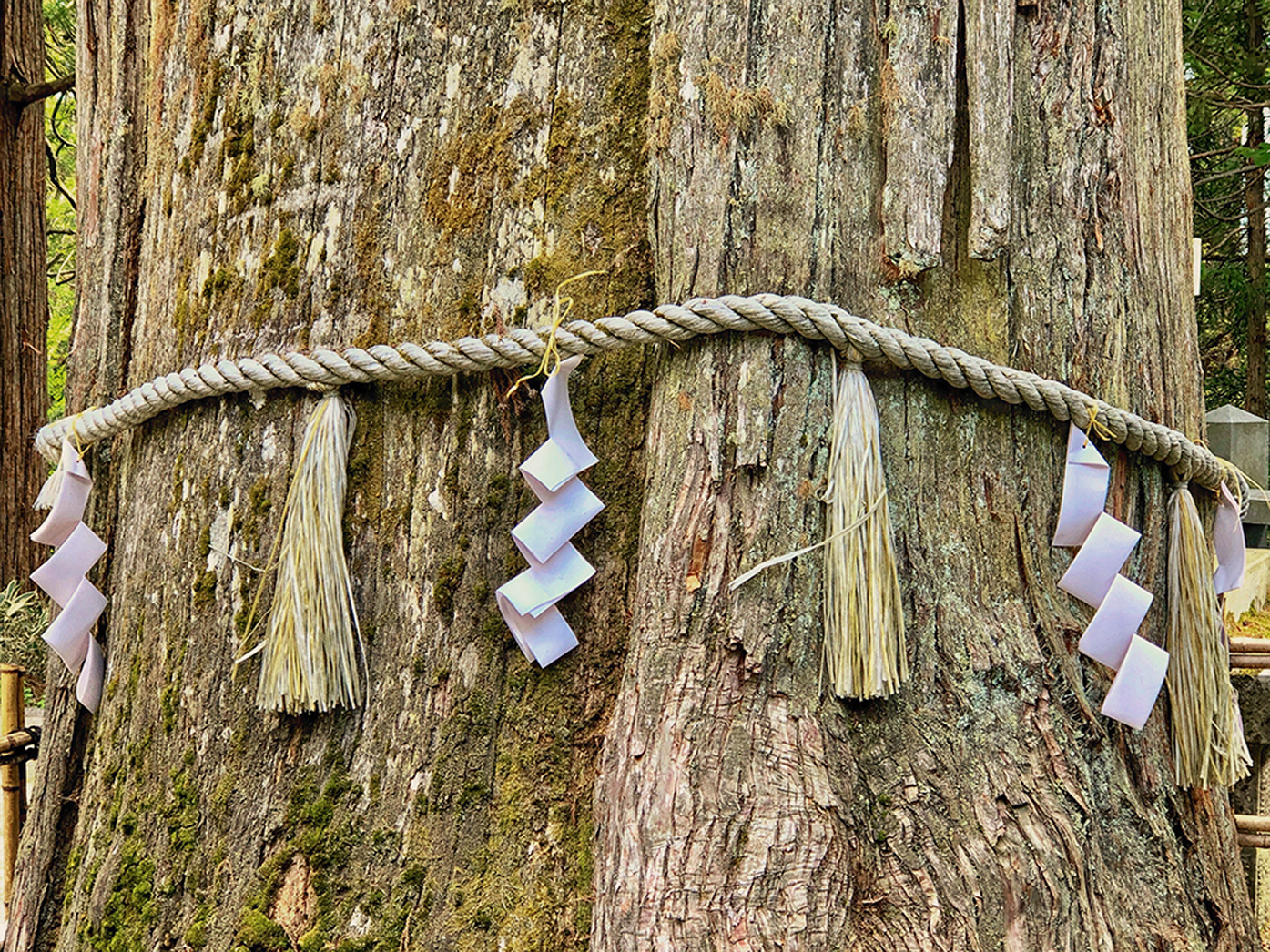
- Saisenbaku: an offering box into which worshippers toss money to the kami (also found at shrine buildings). Near or on them, people may also place offerings such as rice or bottles of rice wine (saki).
- Temizuya: a water font and basin to cleanse the hands and mouth before entering a sacred area. These are an important ritual element of purification on the shrine grounds, but some trees have their own.

- Kannushi: Shintō priests or community members who tend to the trees. Some trees at bigger shrine complexes will be very well-tended. Other, less-visited trees may appear a bit neglected.
- Kodama: “a tree’s soul and echo” are invisible forest spirits, (however, they were at one point in history may have been considered the equivalent of gods).[8] These spirits or goblins of the trees are said to have supernatural power that could protect houses and villages. They may or may not live in a specific tree. And though invisible, may also manifest themselves spontaneously, like the Some liken them to fairies or light orbs that appear and disappear. There are stories of kodama falling in love with humans and taking human form. Ki no kami are like dryads, not deities, that live in trees. Neither of these is to be confused with yokai, or ghosts, some of which can also inhabit forests. No one knows what kodama really look like, however, this is how Miyazaki portrays them in the popular Japanimation film, Princess Mononoke®.
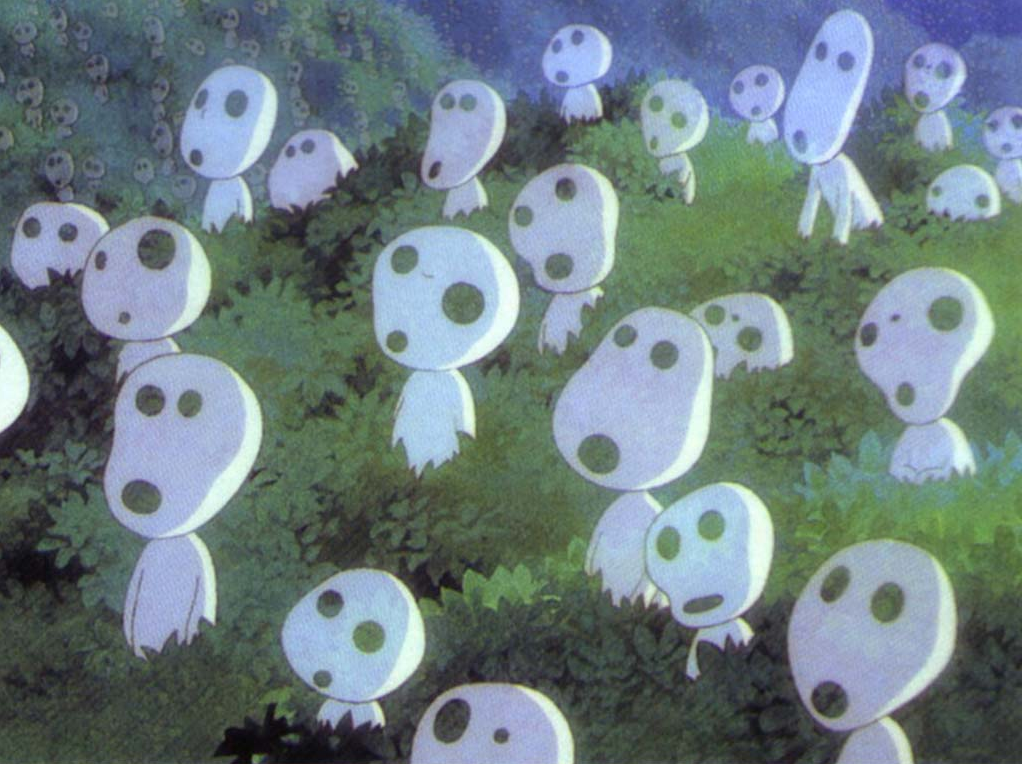
The Five Shinboku Trees Who Forever Changed My Life
-
HIBA
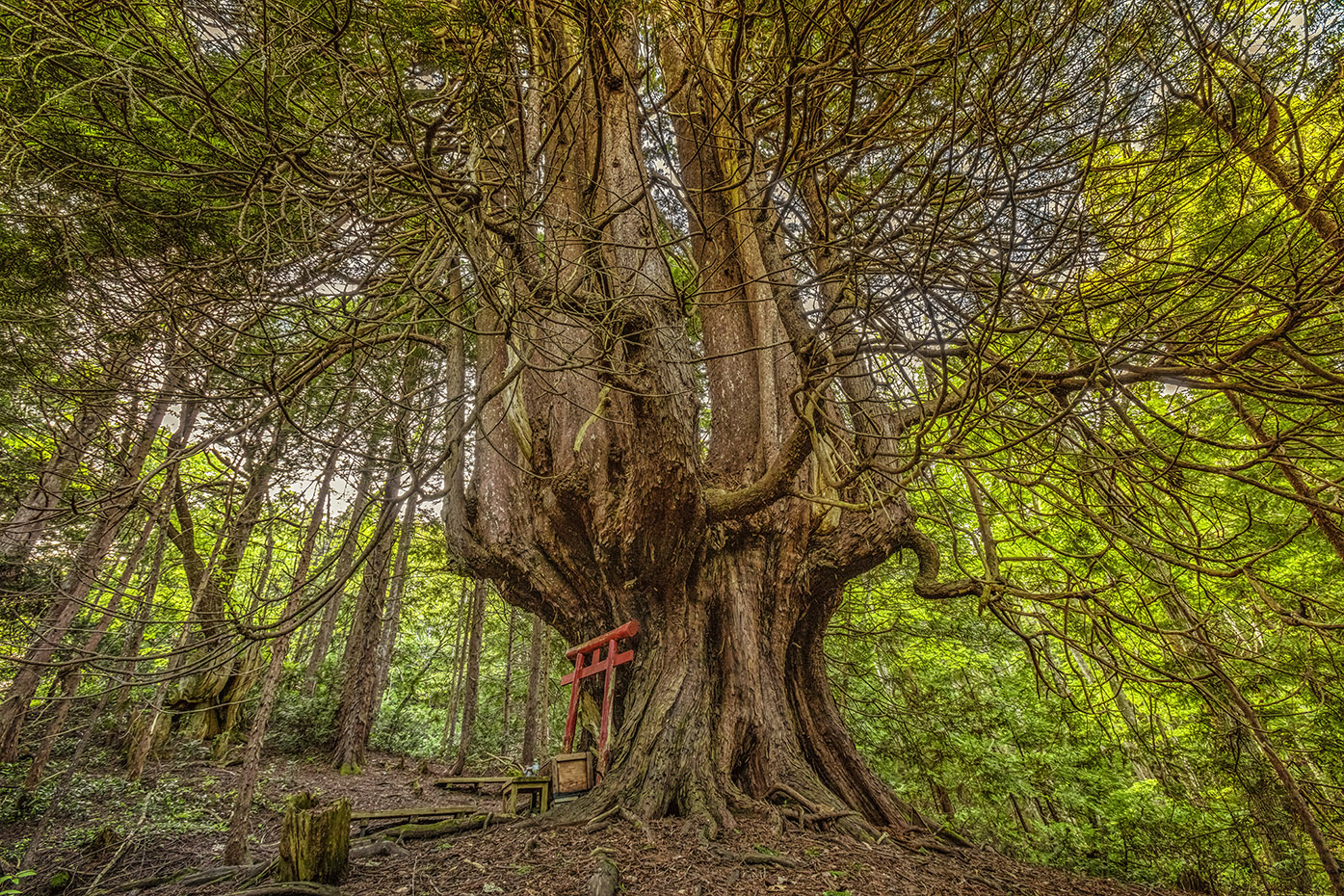
Also known as Asunaro (Thujopsis dolabrata), Hiba is a conifer in the Cypress Family (Cupressaceae) is endemic to the forests of northern Japan. This 800-year-old fantastical tree is notable because of the twelve major branches that extend straight up from the trunk, giving the appearance of a stiff, knuckled, arthritic hand. It is a mystery what caused the unusual shape of what should normally be a standard apical-dominant conifer (straight, tall and pointy at the top). This was possibly caused by coppicing, lightning, or perhaps kami! This sacred tree is known as “Junihon Yasu,” which means “twelve-forked pole which pokes a fish.”
This was the first shinboku tree I experienced, and I had no idea what I was in for. This tree’s location was far off the beaten path in a rural forest in the north of Aomori prefecture, Tōhuku. After almost giving up on our search, my Japanese friend and guide, Kaku and I, finally found a little sign and at the base of a hill. After we crossed under the weathered grey wooden torii and climbed the steps, I felt something extremely unusual and powerful in my solar plexus. The ‘vibration’ felt almost audible like a gong reverberating in my belly. A forcefield of energy was radiating at least fifty feet from the tree and got stronger the closer the tree came into view. I had never felt anything like this before with any tree in the world; it stopped me in my tracks, holding my breath, completely humbled!
When I first saw the tree, I thought, “No, I couldn’t possibly get intertwined with this tree and photograph myself; I don’t even know what’s going on.” (I always ask permission of any tree before photographing myself with one, and if I sense a “no”, then I strictly respect that.) This tree was clearly a shinboku, indicated by a small saisenbaku with recent offerings on it, and a short red torii leaned up against the trunk. (Historical photos show a shimenawa as well.) There did not need to be any visual indicator of its sacredness, however; one could be blind or completely blindfolded and feel the intense forcefield. We followed the protocol as one does when arriving at a shrine: bow twice from the waist with arms at your side, firmly clap hands twice (to signal your presence or wake the kami up) and bow two more times. We cautiously walked around the circumference of this wild dragon of a tree as if we were being.
When I had seen this tree in photographs on the internet, I had visualized myself somehow climbing the tree and sitting up in the nook where the trunk split into twelve. But no, it was clear now that was to be off limits; only foolish, disrespectful young boys dared to climb this tree as a way of conquest. Besides, that biological division in the tree clearly felt like a spiritual one—the twelve branches an upper world, the trunk the middle world, and the shallow hollow at the base a closed portal to the lower world; I didn’t feel comfortable or invited to journey up or down to either.
After I got up the courage to humbly ask permission to photograph myself with him, the kami’s masculine energy changed dramatically, into a protective, but loving, grandfatherly energy. Why the change in energy? I wondered. My intuition was affirmed: the kami made it clear to me that the tree was too dangerous for me to climb, but instead, allowed me to sit at the edge of the hollow at the base, almost like at the foot of a throne.

Time was getting later, and the light was fading. I had to work quickly. I set up my camera and tripod and bowed once more to the tree before undressing and respectfully sitting in a fetal position at the base, not to cause much disturbance. I held my breath unable to completely relax. This was not a place to stay and meditate; it was like sitting like a feather on a holy altar or on the belly of a dragon. Using my remote control, I took a couple shots, and then quickly and respectfully removed myself, tip toeing carefully across the thick carpet of prickly fallen branches, which were connected with the tree’s energy field. I wondered, where did this tree end and the rest of the forest begin with the hundreds of fallen needles carpeting the forest floor?
My friend and I took a few more minutes to compare our experiences. He, too, was awestruck. I so wished that I had gotten our entire reactions and discussion on video. As the light faded, we bowed goodbye one last time in gratitude to the tree and the kami, and left the coming nighttime to adopt this mysterious, sacred place. Someday I hope to return here, with others, curious to witness and capture on film their reactions to the energy of the kami as well.
Later in my journey in Japan, I purchased some rare Hiba essential oil, distilled from the wood, known for its antimicrobial properties. What a treasure: a very earthy scent that captures the essence of this tree’s direct connection with the divine. I inhale it to remind me of the power of this tree’s sacred life force, improve my immune system and help me stay grounded.
-
JAPANESE RED CEDAR
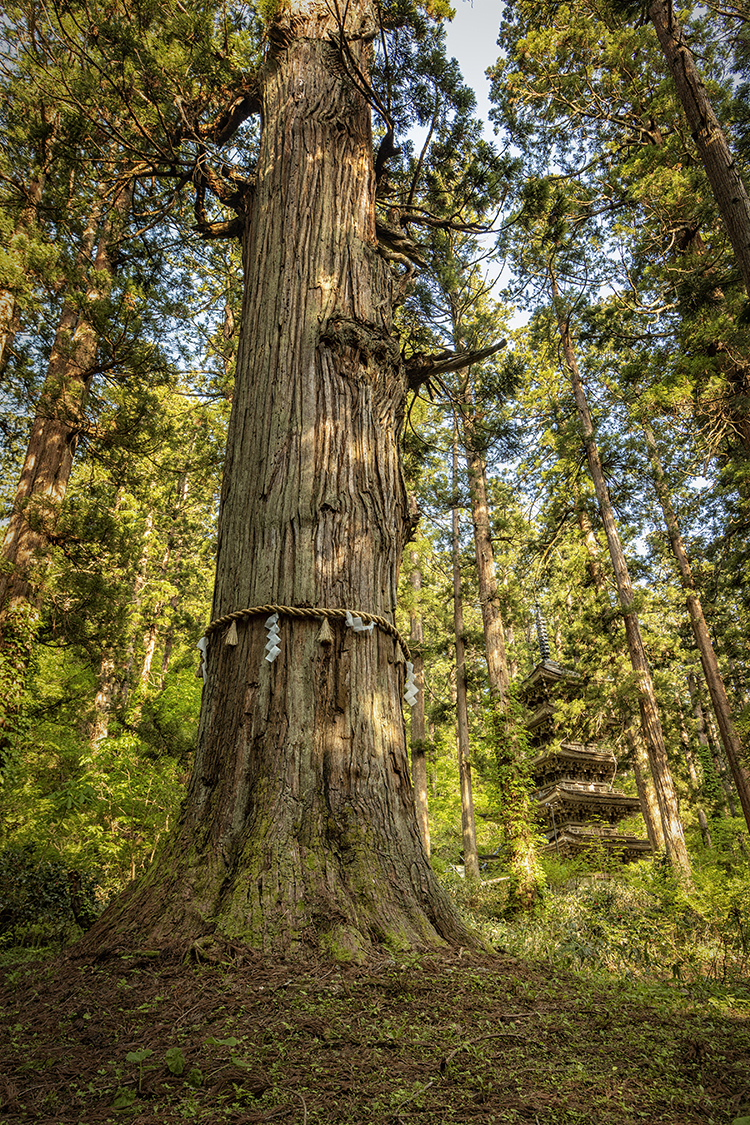 Known as “Sugi” in Japanese (Cryptomeria japonica), this evergreen tree is not a true Cedar, but is in the Cypress (Cupressaceae) Family. Sugi trees have a wide distribution range throughout forests of Japan, but most have been replanted after the major deforestation of Japan. Similar to California Coast Redwoods (Sequoia sempervirens) and Giant Sequoias (Sequoiadendron giganteum), they can grow to a huge girth and age. Sugis are one of Japan’s most well-loved sacred trees. Since they grow big and old, there are often near shrines, with a shimenwa tied around them to indicate their home for a kami.Remnant old-growth Sugi trees and giant regenerating stumps live protected in the ancient rainforests of Yakushima Island, on the far south of Japan, which I also visited. There too, I bought some bottles of rare distilled essential oil with anti-microbial properties, made from Sugi wood. Inhaling that oil helps me ground both up into the sky and down into the earth.
Known as “Sugi” in Japanese (Cryptomeria japonica), this evergreen tree is not a true Cedar, but is in the Cypress (Cupressaceae) Family. Sugi trees have a wide distribution range throughout forests of Japan, but most have been replanted after the major deforestation of Japan. Similar to California Coast Redwoods (Sequoia sempervirens) and Giant Sequoias (Sequoiadendron giganteum), they can grow to a huge girth and age. Sugis are one of Japan’s most well-loved sacred trees. Since they grow big and old, there are often near shrines, with a shimenwa tied around them to indicate their home for a kami.Remnant old-growth Sugi trees and giant regenerating stumps live protected in the ancient rainforests of Yakushima Island, on the far south of Japan, which I also visited. There too, I bought some bottles of rare distilled essential oil with anti-microbial properties, made from Sugi wood. Inhaling that oil helps me ground both up into the sky and down into the earth.
Tree fanatics know that the biggest, oldest, and most famous tree of all species in Japan is a Sugi called the “Jomonsugi.” Estimated at between 2,000-7,000 years old (named after the Jomon period in history), the tree lives so deep in the rainforest of Yakushima Island that visiting him requires an arduous, rainy twelve-to-fifteen-hour round trip hike over slippery roots and rocks. Unfortunately, due to a closed trail, I was unable to make that epic trek on my journey where Jomonsugi lives, deep in the Shiratani Forest on Yakushima. So that was not the Sugi tree who blew my mind.
The Sugi tree who did is the less ancient tree known as “Grandpa Sugi” (“Jiji Sugi,”) at the Mt. Haguro Shrine Complex in Akita Prefecture. Estimated at 1,000 years old (likely overestimated), the stately Grandpa Sugi is very accessible and widely photographed with the 1,000-year-old pagoda-style shrine nearby. For this reason, I had considered photographing myself with the tree when I first saw photographs of him on the Internet.
However, when I met Grandpa Sugi in person, my intentions immediately changed. Despite the fact the tree was in a very public spot at a very busy shrine complex that would make it impossible to get naked with, the energy field of this tree was so phenomenally powerful that I felt like a speck of dust on the ground—he is that holy! I felt a similar feeling in my solar plexus that I did with the Junihon Yasu Hiba tree, but this feeling of phenomenality was slightly different—less deep and earthy, and more towering and upper-worldly like a cathedral. That helped me understand that each kami has a unique character, personality, power and energetic vibration, not just each species of tree. This tree lives within a large shrine complex—an entire sacred mountain imbued with the energy of many deities and visited by thousands of people every year. That could explain some of the power I felt.
I followed the shrine protocol of two bows, two claps, and one bow, but did not pray for anything in return; I was too much in awe, so I simply thanked the tree for existing and took a photo of the tree himself with the shrine in the background. Unlike the Junihon Yasu Hiba tree, I did not feel that this kami was even slightly aware of my presence. My previous interspecies communication skills with hundreds of trees as TreeGirl meant nothing to this kami. Although I have experienced other trees saying no to me when I asked to photograph myself with them, this was completely different; I felt completely unworthy of even approaching, communicating with or touching this tree. That was life changing.
-
KATSURA

Katsura (Cercidiphyllum japonicum) are deciduous broadleaf trees native to Japan and China and are near threatened in the wild. This particular shinboku I met is special because she is not a single-trunked tree, but rather is comprised of over eighty uniform trunks that re-sprouted on the outer edge of a giant, ancient stump, leaving a hollow containing a mini-ecosystem inside. Known as The Grand Katsura of Itoi, this botanical wonder is designated as a National Monument, has a circumference of 19.55 m, and the entire regenerating tree has been estimated at about 2,000 years old. Adorned with a shimenwa, the tree is a shrine unto herself, living a peaceful life in a forest far from any building, near the small town of Wadayama in the Hyogo Prefecture.
My Japanese friend and guide, Maki and I approached the tree with deep humility, bowing to show respect, and clapping to announce our presence. We sat on the ground in awe a distance away from the tree, taking in the palpable field of energy. I could feel the kami of this tree as very feminine and regal, but approachable. Suddenly our peace visitation was shattered when a noisy SUV drove up (bypassing the remote parking area) and parked directly behind us. A middle-aged Japanese couple approached the tree, ignored the Shintō shrine etiquette, and proceeded to tromp around the tree, snapping an obligatory tourist photo. They then drove away as disruptively as they had arrived. I was shocked that they could not feel the presence of the kami and act accordingly. They seemed to have a lack of humility and respect for both nature and the sacred Shintō culture. It is said that one connects with the kami through one’s heart. How they could they be closed off to the energy of this magnificent tree?
My friend and I continued on, having our own separate experiences. I introduced myself to the tree and kami and communicated my intention. I respectfully circumnavigated the tree and saw several openings where I could enter inside to the mysterious hollow center, if allowed. I didn’t dare enter without permission; this was clearly a sacred place. After asking, I felt that indeed, yes, I did have permission, and I photographed myself intertwining with the exterior of the sprouted trunks.
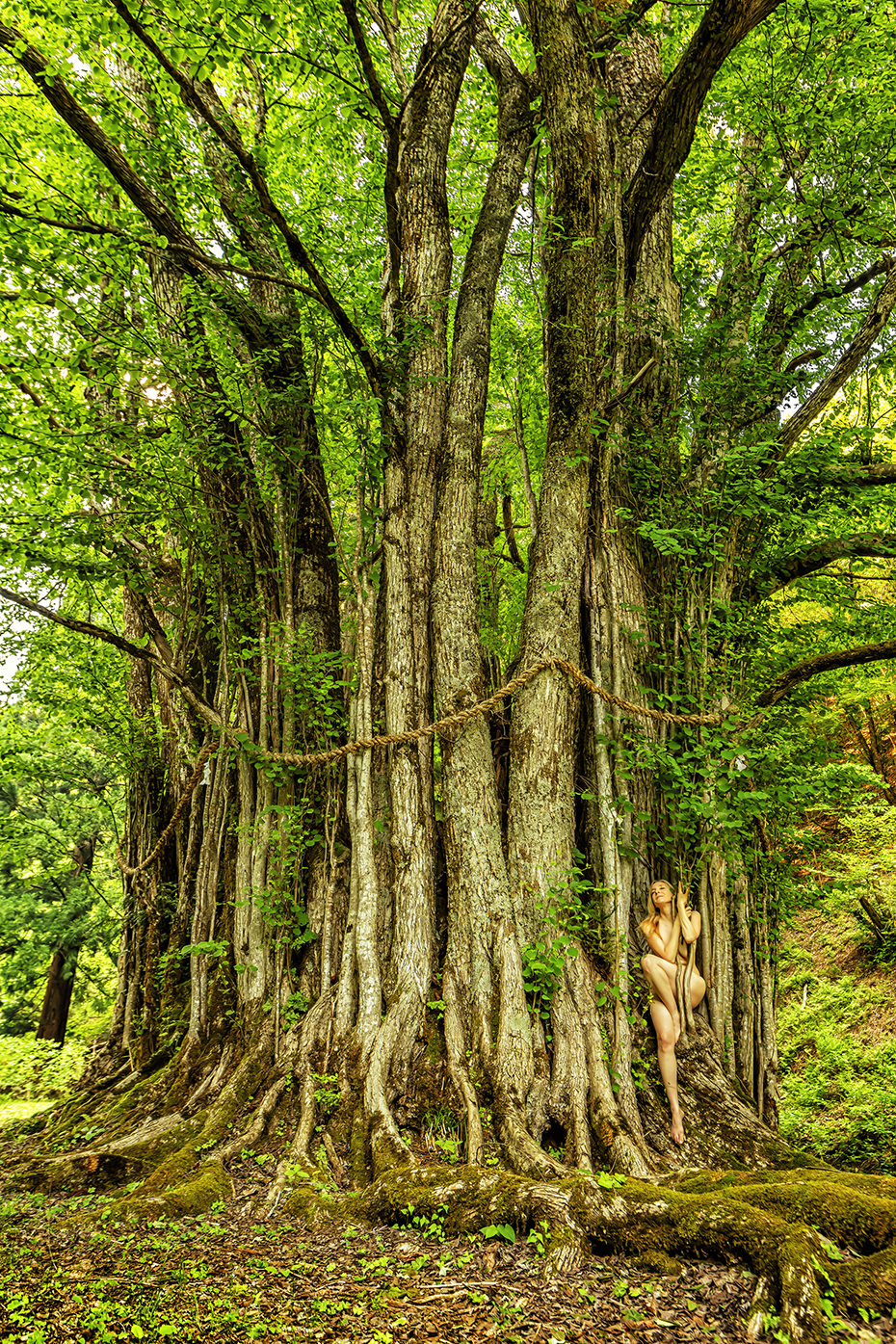
Then I “heard” an invitation to “enter… enter.” Oh, how fortunate: a portal was open for me! I climbed inside like Alice in Wonderland. What would I find? It was a fairy wonderland, a separate ecosystem of moss, plants, and small caverns formed by the original decaying stump—a haven for many small beings, seen and unseen. Looking up into the canopy, the golden green light filtered in, creating the feeling of a sacred sanctuary. I imagined how beautiful it would be in autumn when the heart-shaped leaves turned golden yellow. I even captured footage of a blue light orb within the tree—a resident kodama perhaps? My heart was in a state of elation, which often happens when I am free to engage with a tree in this kind of spontaneous creative, spiritual connection.
The entire two hour experience with the tree felt dreamy, like a sequence from an animated Miyazaki film. I took more and more shots, until at one moment I intuitively felt it was really time to go—and go now. I often sense this (and deem it a message from the tree) because someone is approaching and I might be seen, but this was an isolated area and I felt secure in my privacy in a bubble of sacred time and space. I kept pushing against this message trying to get one more shot, until I “heard” a firm edict from the kami: “Enough. Time to go—Now.” Oh dear… “Just one more shot, please?” I asked. Absolutely not. The kami of the tree was loud and clear, and I had no choice but to honor her. You cannot disobey a deity; that would surely mean life-threatening trouble. So, I promptly, but sadly, left the cavernous fairy world though the back portal and ended my photo shoot with one last exterior embrace. My friend and I said a grateful thank you to the kami and goodbye to the Grand Katsura tree, bowing again. Just then another car pulled up, carrying more tree enthusiasts. Perhaps the kami was looking out for my privacy, as well as taking care of herself, when she told me to stop. I packed up my things, only later to find that I had accidentally left my camera lens cap and my precious remote control behind—as offerings, perhaps.
The entire sacred experience with the Katsura was a first for me: I had pushed the boundaries of a deity inhabiting a tree. I later regretted being so selfish. I was fortunate, though; she let me have my beautiful shots and leave safely, with only a few itchy insect bites on my leg (reminding me to also always ask permission of the inhabitants living on the tree). But would the portal be open for me again if I ever returned?
CAMPHOR
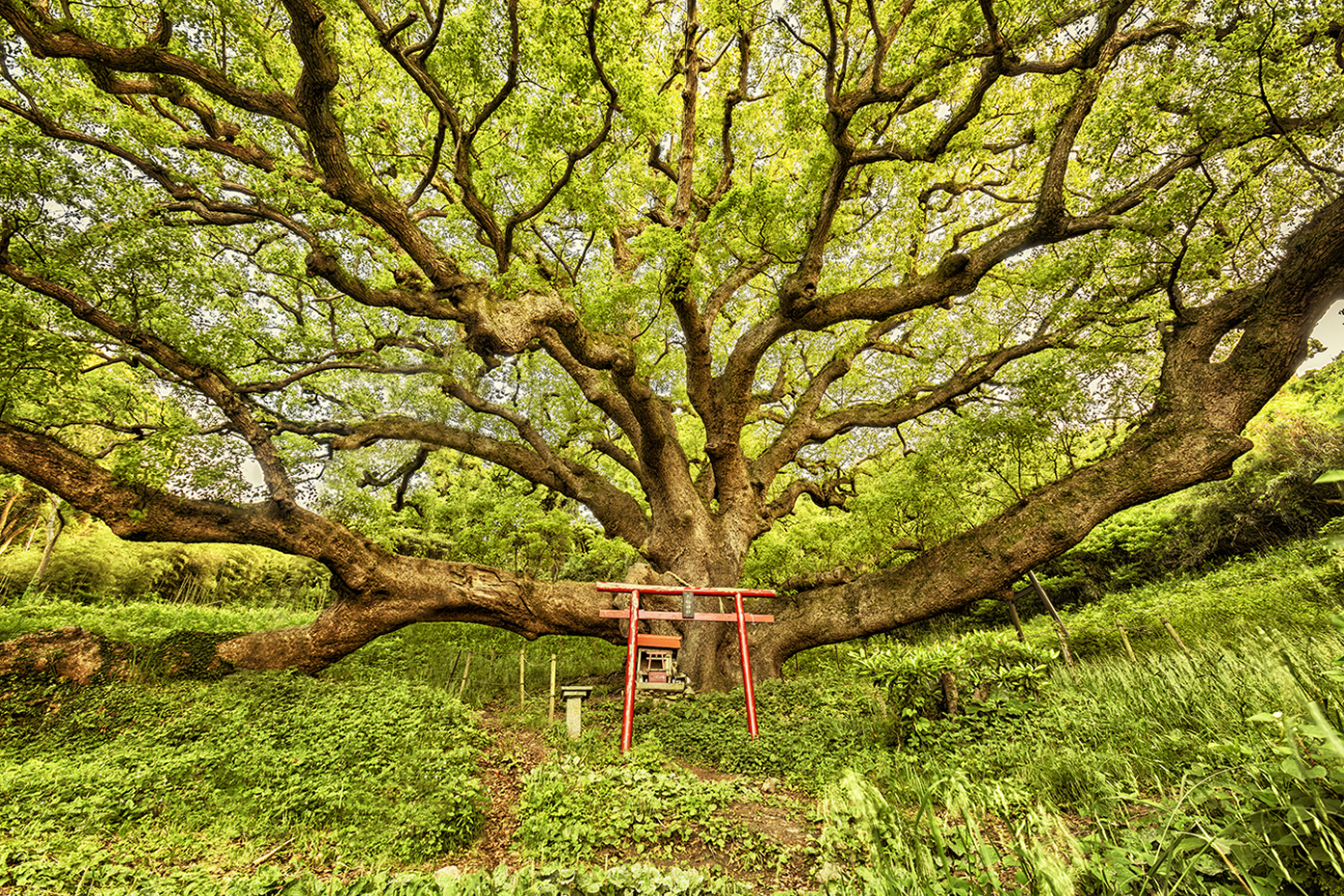 Known as “Kusu” or “Kusunoki” in Japanese, the evergreen broadleaf White Camphor tree (Cinnamomum camphora) is native to Japan, Korea, Vietnam, and China. Medicinally, the potent camphor oil distilled from the leaves is used in ointments to clear the lungs. In person, this tree is indeed sweetly fragrant, evident when crushed the leaves are torn or crushed. Camphors are not uncommon in Japan, and often grow to an impressive size, and honored as shinboku.
Known as “Kusu” or “Kusunoki” in Japanese, the evergreen broadleaf White Camphor tree (Cinnamomum camphora) is native to Japan, Korea, Vietnam, and China. Medicinally, the potent camphor oil distilled from the leaves is used in ointments to clear the lungs. In person, this tree is indeed sweetly fragrant, evident when crushed the leaves are torn or crushed. Camphors are not uncommon in Japan, and often grow to an impressive size, and honored as shinboku.
I unexpectedly fell in love with an exceptional 1, 200-year-old Kusunoki known simply as “Okusu” who resides in solitude on the small former fishing island, Shishi in Kagawa Prefecture. Once bustling, but now barely inhabited by just eighteen people, with no automobiles, the island and tree are reachable only by ferry (and, there is only one place to stay for tourists). I knew that the tree would be spectacular, and I hoped that there would be a good chance of getting plenty of private time for photography with her on this sleepy island. Many people had visited the island to see the famous tree, but we had to keep my artistic TreeGirl mission a secret.
After being shown our humble rental house, we took the 15-minute walk to the tree before sunset. The tree was more magnificent than in any photos I had seen online. Perched on a gentle slope facing the water of the bay, the tree’s two massive 60-foot-long lower branches stretched out like arms in a wide open in gesture, as if expansively taking in the view and embracing it in return from dawn till dusk. One arm was almost completely rotten where it attached to the trunk, but it extended enthusiastically and ended in what looked like an antlered head of a dragon with an obvious snout and pair of eyes.
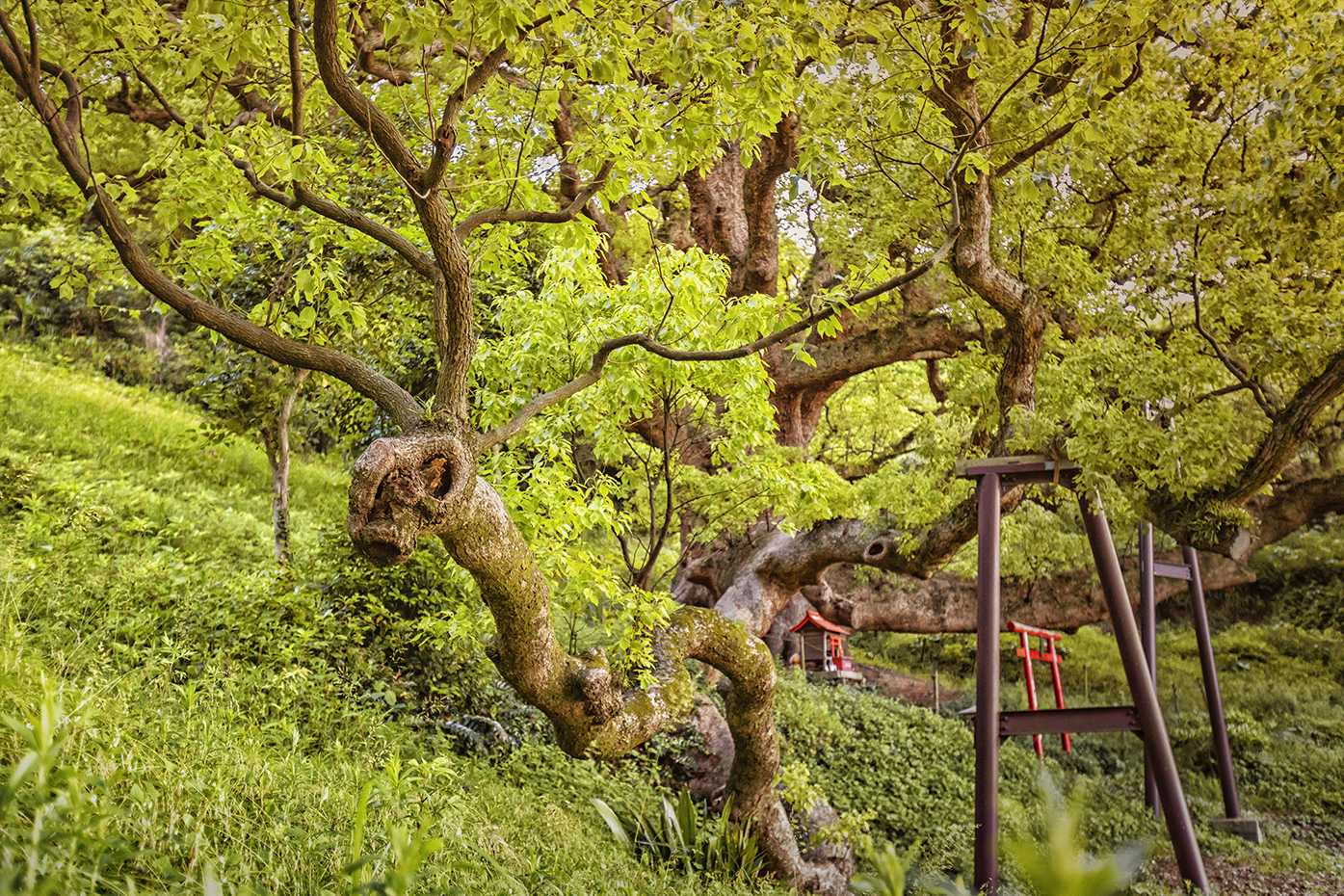
Within the same branch was hidden yet another face, with small knots for eyes. Were these the faces of the kami, kodama, or the spirit of the tree itself?
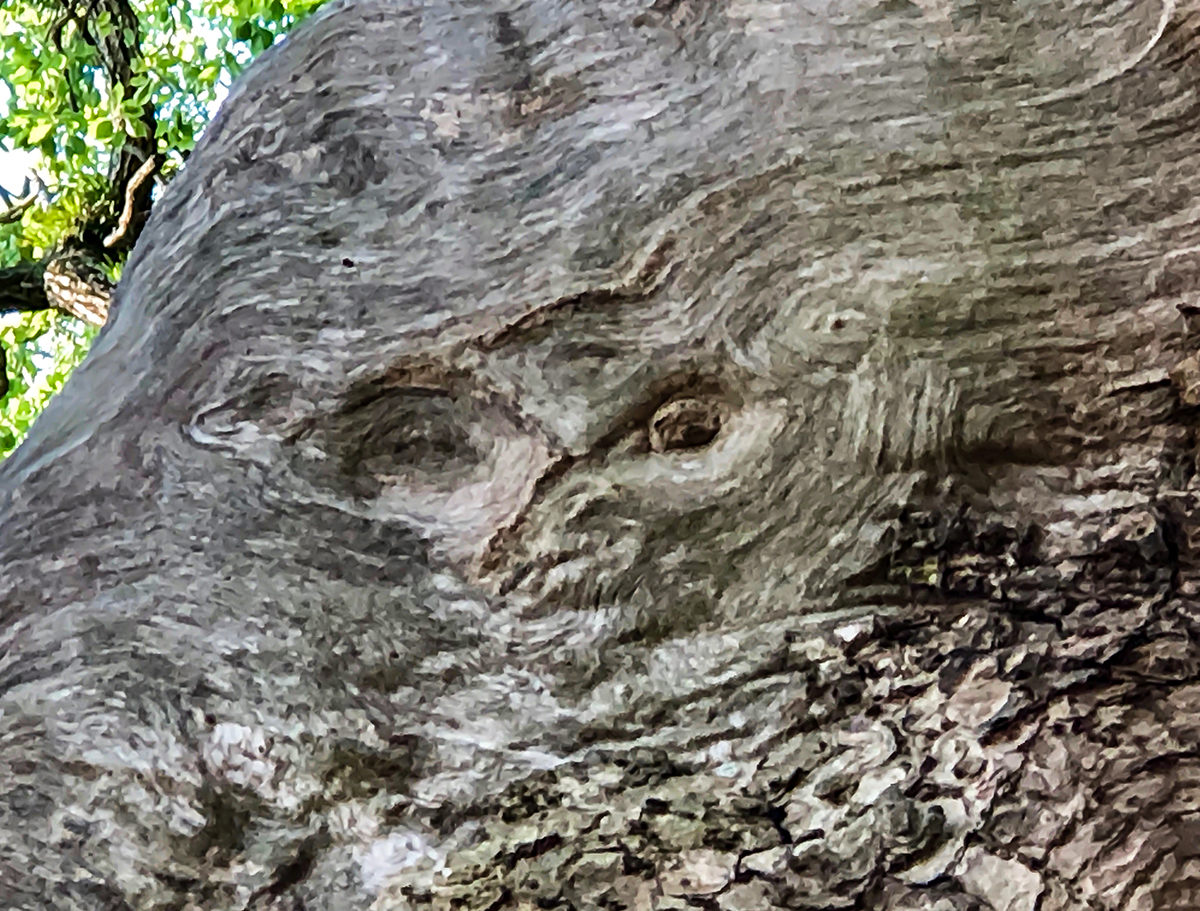
The tree is marked by a tall red torii at the canopy line, and a simple shimenawa encircles her trunk. It is obvious that the island community keeps the vegetated area around the tree from growing into a jungle. The air carried a sweet fragrance of the small white flowering groundcover, while exotic sounding birds called overhead, and in the distance, we heard the sound of water peacefully lapping on the shore––paradise. I bowed before walking under the torii, then walked around the tree in an almost giddy state. The tree’s energy was powerful in a loving, feminine way; her gesture of open arms was at once gracious and welcoming, the branches reassuring in their massive strength. The sun was quickly setting, and it was too dark to photograph now; this was merely a spiritual meet-and-greet. We would return at sunrise the next day for best light.
The next morning, we arrived just a few minutes too late to take good photographs; the sunlight had hit the tree, causing harsh washes of light and shadows. I was significantly upset at myself for sleeping in. I had to do what I could with the conditions and time we had. One of the tree’s massively long main branches looked like it would be easy to climb into. I asked permission and felt no reason to hesitate; it was safe to do so, and I was welcome. Once I was up on that branch, sitting on her massive arm gave me an amazing feeling of security, like being tucked against the chest of a prehistoric mama bear. I crushed a leaf to smell the fragrant medicinal oils for a full sensory experience. I then moved to her other arm, where I found my spot of absolute peace. Looking up into the leafy canopy against the blue sky, which can only be appreciated from within the tree’s embrace, I entered a state of euphoria; I was in love.

I could have stayed with this tree forever, but our ferry back to the mainland was about to arrive and we had a long day’s journey ahead of us to get to the next tree on my the treasure map. This was a too-brief encounter and I vowed I would come back. I had unexpectedly met my now-favorite individual tree as well as my now-favorite tree species: Camphor.
- CAMPHOR 2

In the city of Takeo in Saga Prefecture is the small, beautiful Takeo Shrine, first built in 739AD. Behind the shrine is a sacred bamboo grove and the remnants of an ancient camphor forest. Here resides the phenomenal, ancient Takeo Camphor.
Once again, I arrived on site with my native Japanese translator friend, Maki to guide me through the proper Shintō shrine protocol. At the entrance of the pathway to the tree is a temizuya, with which to purify one’s hands and mouth, just for the kami of the tree. As we walked toward the tree, it felt as if we were like tiny hobbits in a Tolkien film, approaching a giant Ent, one of the wise elders of the universe.
Designated a natural monument of the city, this camphor is the seventh largest in Japan, and estimated at over 3,000 years old. The tree is 30m high and has a circumference of 20m at chest height. This tree is indeed a veteran, with large upper cavities where two major limbs fell away long ago.
There is at least one obvious mask-like face in the old, wrinkled, decaying trunk at the edge of the limb cavity; it resembles an unraveling mummy with its mouth open, but with a voice I could not hear in waking consciousness. The face is not as disturbing as it is mysterious. My intuition was that it may be the face of the spirit of the tree (not the kami), or perhaps kodama. Almost every shinboku tree I met had at least one face in the bark.
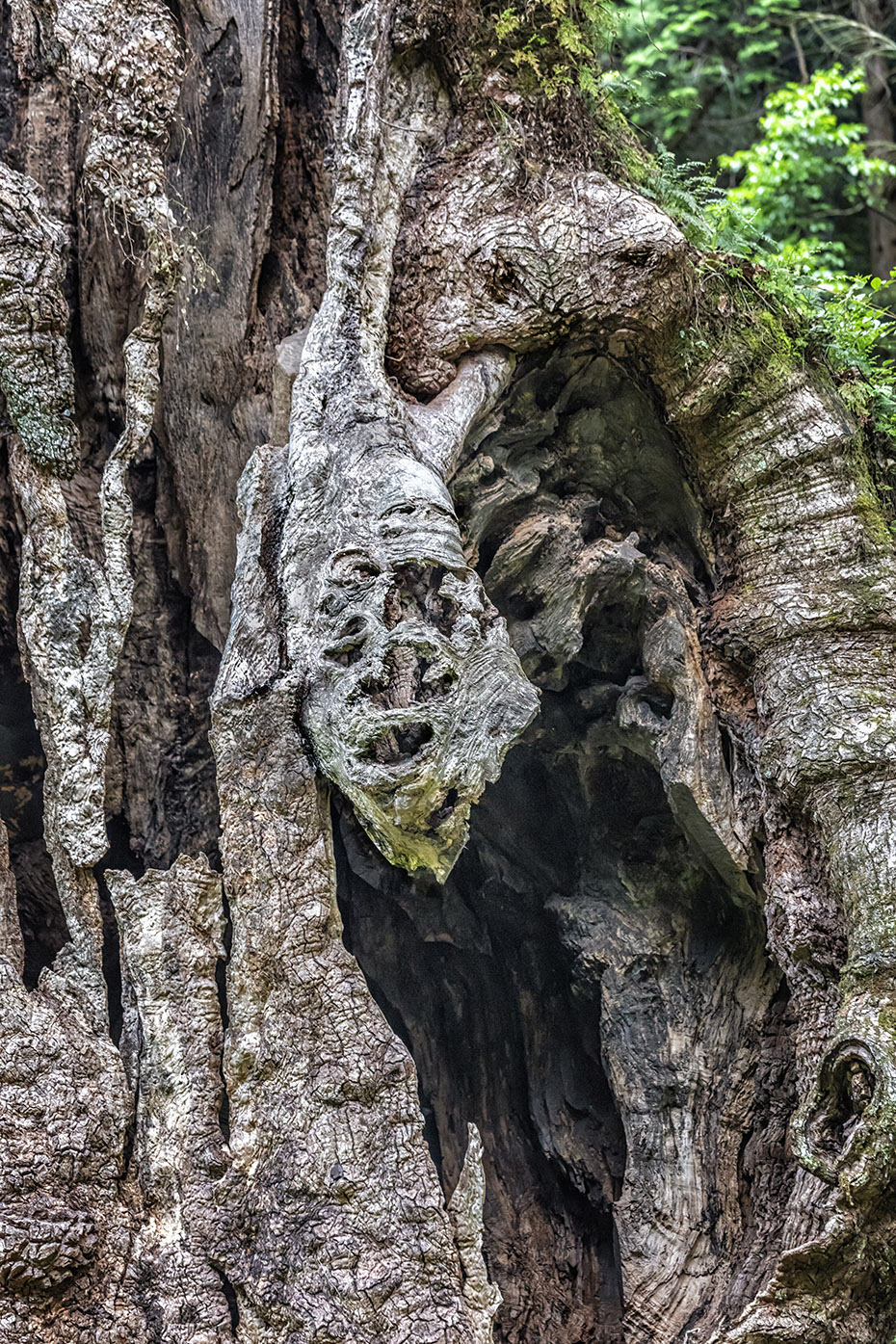
A series of small concrete steps lead up to the mouth of the sacred cavern—an incredibly inviting place to enter. The trunk is strung with a shimenawa, and at the base is a wide-mouthed, bulbous cavity of about 20 sq. meters with its own windows. Inside, there is an old altar where visitors have left offerings and a small round mirror, which is where the kami is said to travel between worlds to take form.
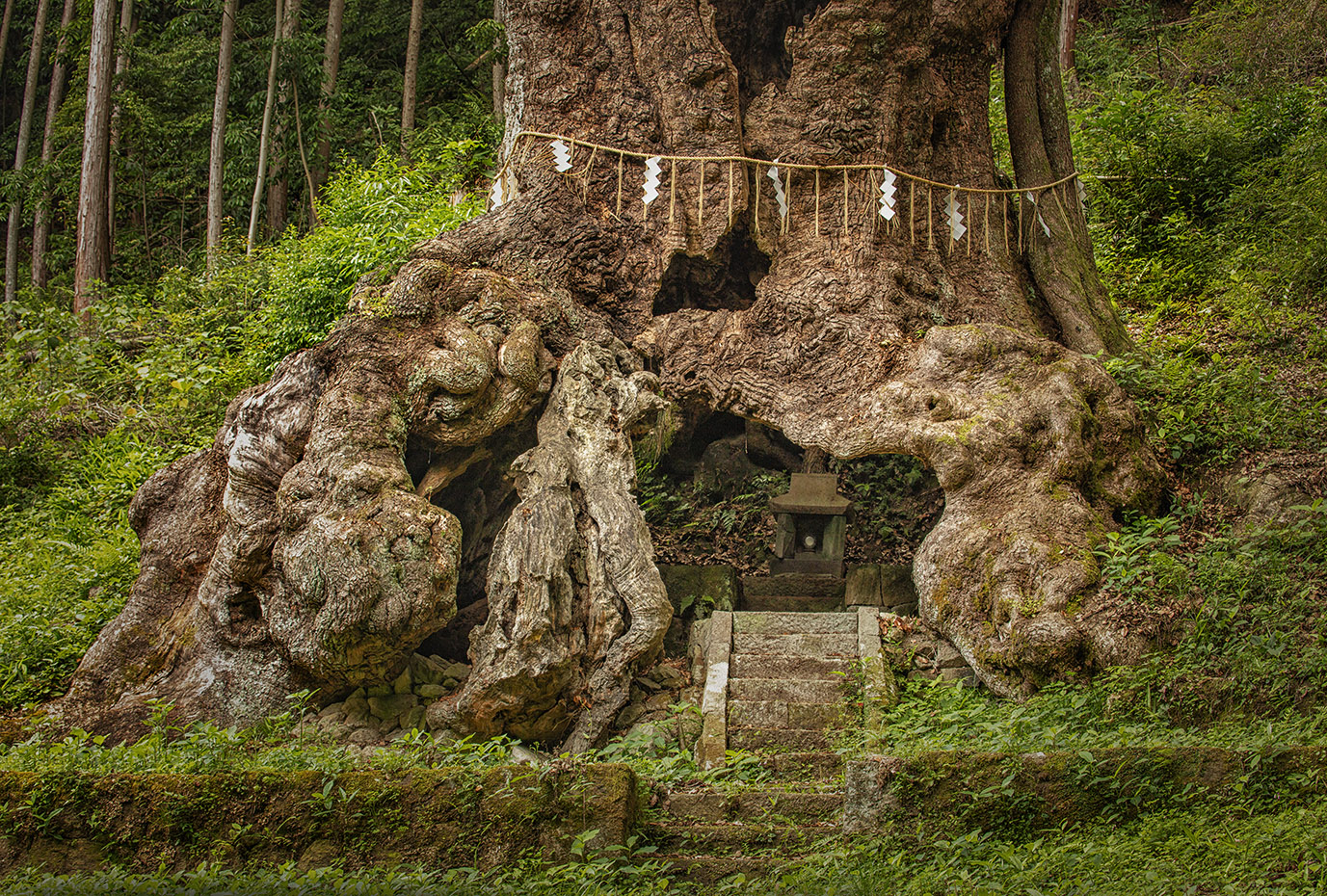
We took as much time as was available to us, visiting the tree twice, once at dusk and once early the next morning; both times, to our luck, we had complete privacy with the tree. On our dusk visit, the character of the kami felt very protective, similar to my first experiences of approaching other shinboku trees. I didn’t dare approach the tree more closely at first; it did not feel right, and I always listen to my intuition. Besides, this tree had a fence around it and a warning sign that the tree was old and fragile and to not enter. But that had never stopped me with other trees who gave me permission to approach them with care. I had a decision to make.
That night, back in my room, I was still completely in awe. I felt that this was by far the most sacred tree I ever met. Ever since I first saw photos of this tree, I had longed to crawl into her womb. I had traveled such a great distance to meet this tree in person, and I struggled with what to do: what would it mean to photograph myself with her? On the other hand, how would it feel to give up the opportunity? I could not force things; the permission had to come from the tree—in this case, the kami. Then I remembered having seen photos of people, perhaps a Shintō priest, inside the hollow of the tree, making offerings. Could my own humble, artistic presence be accepted by the kami as such an offering?
By the next morning, I had decided: I would boldly and respectfully ask the kami for permission to enter the tree’s cavern. This time, the character of the kami felt completely different; the energy was softer, more feminine, more goddess-like. The protective guardian energy was now negotiable. I wondered why I sensed two totally different personalities, much like with the Hiba tree. I felt a “yes, you may take the photo,” but once again, I sensed that I had to be quick about it; I myself was not a Shintō priestess or a maiden (at least in this lifetime); I was a foreign visitor. Besides, I could be seen at any time by an unsuspecting tourist walking down the path, or even a Shintō priest perhaps coming to do his daily duties. I was quite nervous, but with the aid of my friend, I set up my tripod and quickly got undressed. As I cautiously stepped up the steps toward the cavern, I noticed just at the edge… oh dear, lots of mosquitos—a form of shrine guardian (komainu), perhaps. I had to be quick. I ‘posed’ with the tree the only way I felt it was appropriate: humbly crouched down in a kind of fetal position, just on the edge, not inside, as a kind of offering. It wouldn’t have been respectful to climb or lay on any other part of the tree as I first envisioned; I was sure of it now. With my friend holding the remote control, we quickly took a couple shots. I felt incredible to be close to this sacred energy, and I have no regrets. But this was not like the cozy, blissful feeling I often get of “coming home” to nature and merging my body with the body of the forest; instead, this was more like a visitation from a timeless entity that I went through a portal to encounter.
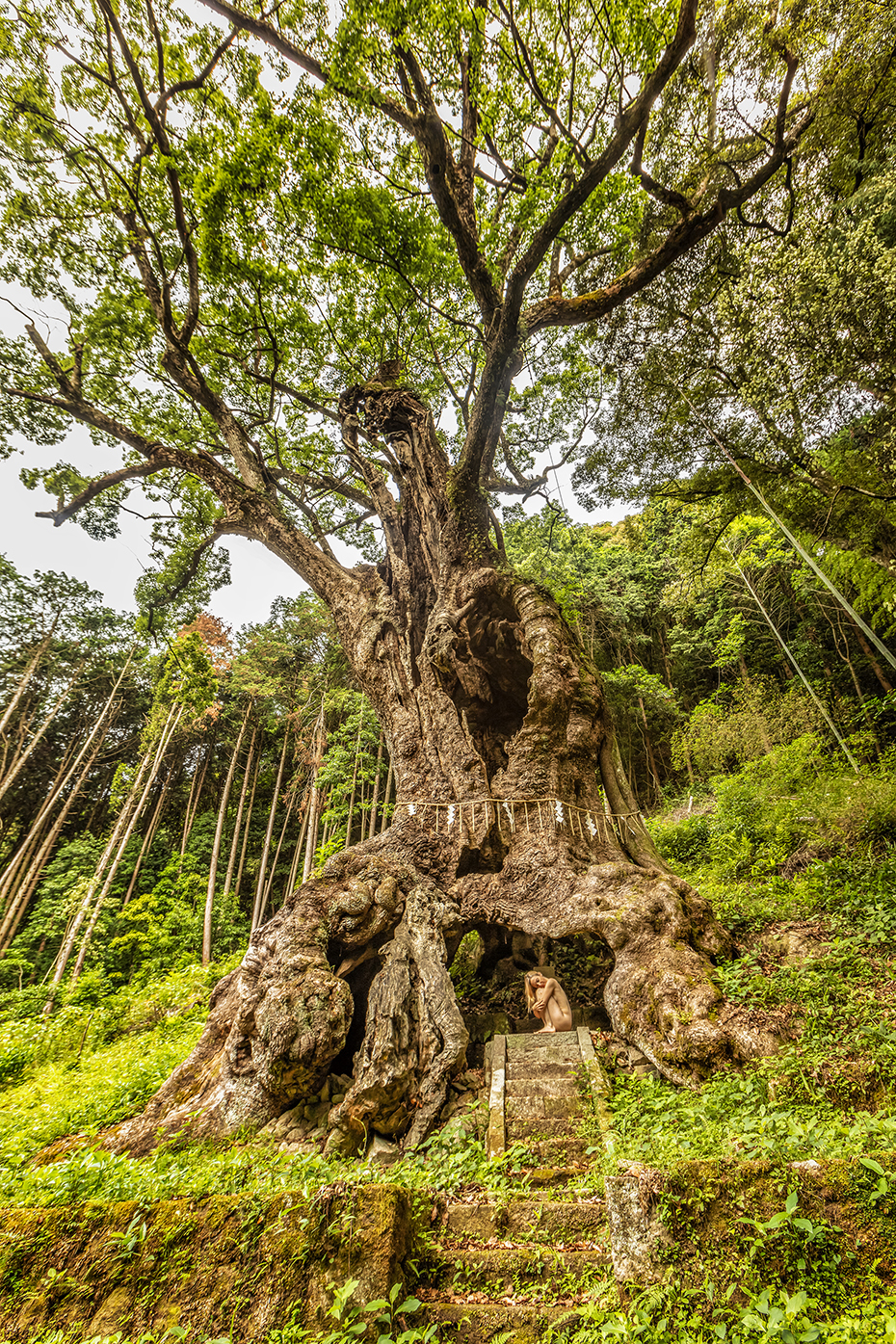
It is said that the kami who is enshrined in (brought into) this tree is the deity of academics, scholarship, and learning—Tenjin (“sky diety”), an ancestor poet who died in 903AD and was later deified by the Shintō priests. Of course, I was not raised in the Shintō belief, but I just didn’t feel that he was the kami in that tree. The first experience I felt a force field that was protective. The second time, I felt someone feminine, and certainly trees with openings to womb-like spaces feel like a portal inside the universe or “yoniverse”, the void of all creation. Could there be multiple energies inhabiting the tree?
In my experience, the entity of the Takeo Camphor is pure holiness. I have never before used that word to describe anything or anyone, but I cannot put it any other way. Perhaps it is like the equivalent of having a private audience with His Holiness the Dali Lama or His Holiness The Pope. I’ve never had either, but I can’t imagine that would even be quite it, because the kami of this tree is pure spiritual energy without a human body. The form of the tree looks and radiates something beyond ordinary reality—something phenomenal. The tree is said to be one of the most spiritual places in Saga Prefecture; I would add that it’s one of the most spiritual places in all of Japan, and even the world! I felt so deep in my being that, if I could take six months off from my normal life, I would come here and solely be in service of this tree and the kami. Some Westerners describe this sort of feeling with gurus of India, but that has never appealed to me; this form of learning and “worship” with a sacred tree does. If I could visit the tree every day for extended periods of time, be in the presence of its energies, listen to what wisdom the kami—the spirits, this mysterious force of energy—has to offer during its remaining years, I felt strongly that it would be a great act of service to the tree, the kami deity, and perhaps even humanity. I can’t explain it, but that’s what I felt deep in the trunk and roots of my own body.
Before I left, I bought and hung a Ema board—like a prayer card—on the back of which I wrote my gratitude to the Takeo Camphor and my wish to return someday, another way to seal the bond I had formed.
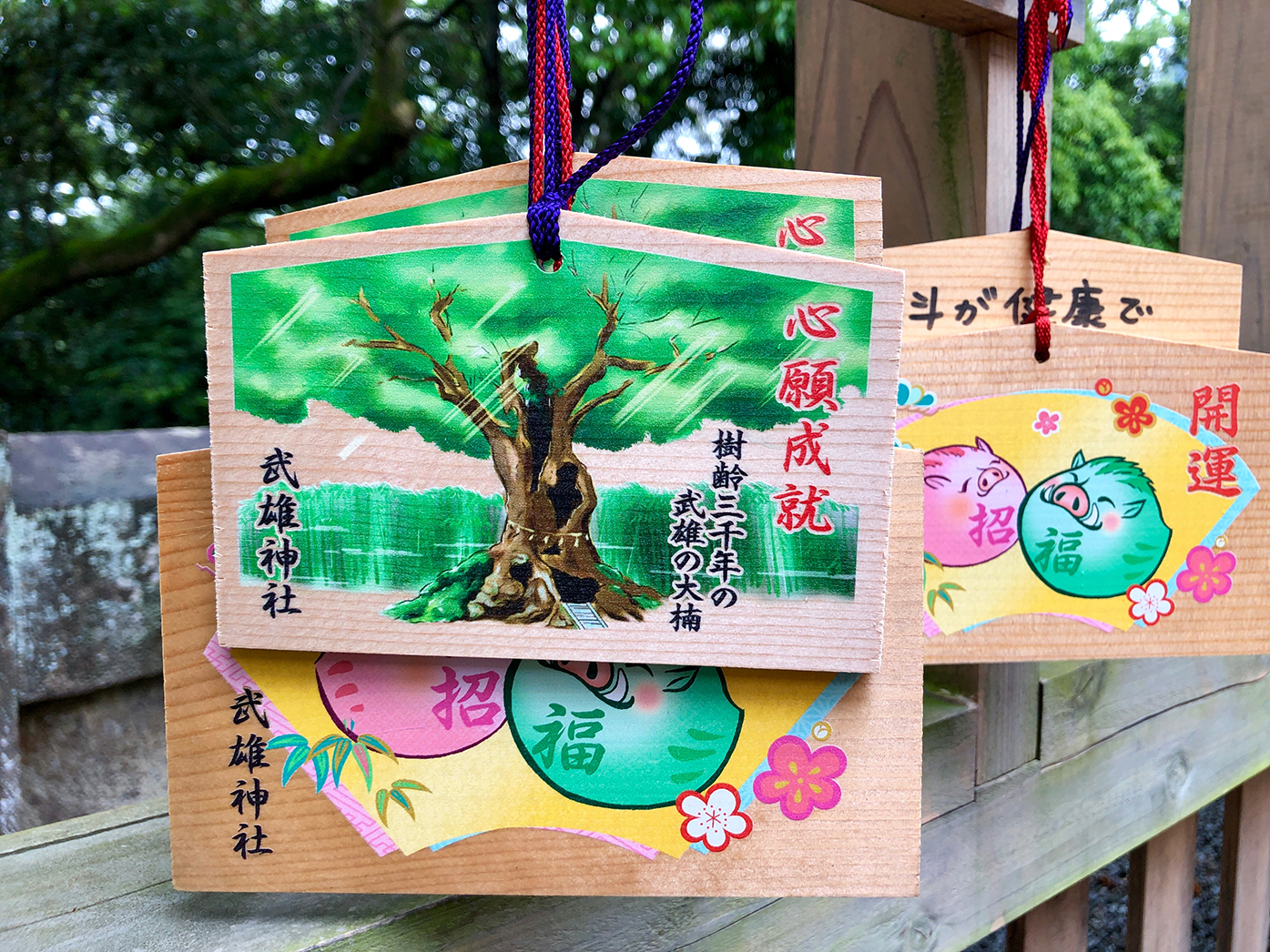
Suspicions and Conclusions
After spending thirty-one days journeying across the island nation of Japan, experiencing just a fraction of its sacred trees and forests, I left with not only beautiful photographs, but with my spirit and heart fuller than I could have imagined—and with more questions than answers:
- Why are deities and spirits so undeniably inhabiting and radiating palpable energy from these trees in Japan, as opposed to other ancient, large, or unusual trees in other parts of the world? Are there deities (not just spirits) residing in trees anywhere else in the world?
Certainly, I’ve experienced for myself and heard other people refer to “the spirit” of trees, and even sometimes to separate “spirits” living in trees. Nearly every animistic culture validates that experience. This was the first time I experienced what I believed to be ‘gods’, however. I believe it is only modern, techno-fied Westerners who don’t generally believe in, or experience nature, as animate—alive with spirit. But kami feel completely different energetically than any other energy I’ve encountered. My sense is that these shinboku exist because these trees (and rocks, etc.) are “activated,” or energetically potent because humans have been praying to, worshipping, and honoring them for hundreds, sometimes thousands, of years. Thus, there is an exchange between the deity or spirit and the human. This type of phenomena is familiar with certain ‘holy’ objects, shamanic tools, ritual masks, or religious or spiritual statues imbued with power which have been ‘worshipped” over time. When they get disregarded, they lose their charge. These kami have no reason to hide and protect themselves from disbelief or persecution; they are boldly holding space in these trees, and the more humans exchange energy with them, the stronger their energy becomes. However, it seems likely that there must have been or are trees like this in other parts of the world, because of the prevalence of animistic cultures before the dominance of monotheism.
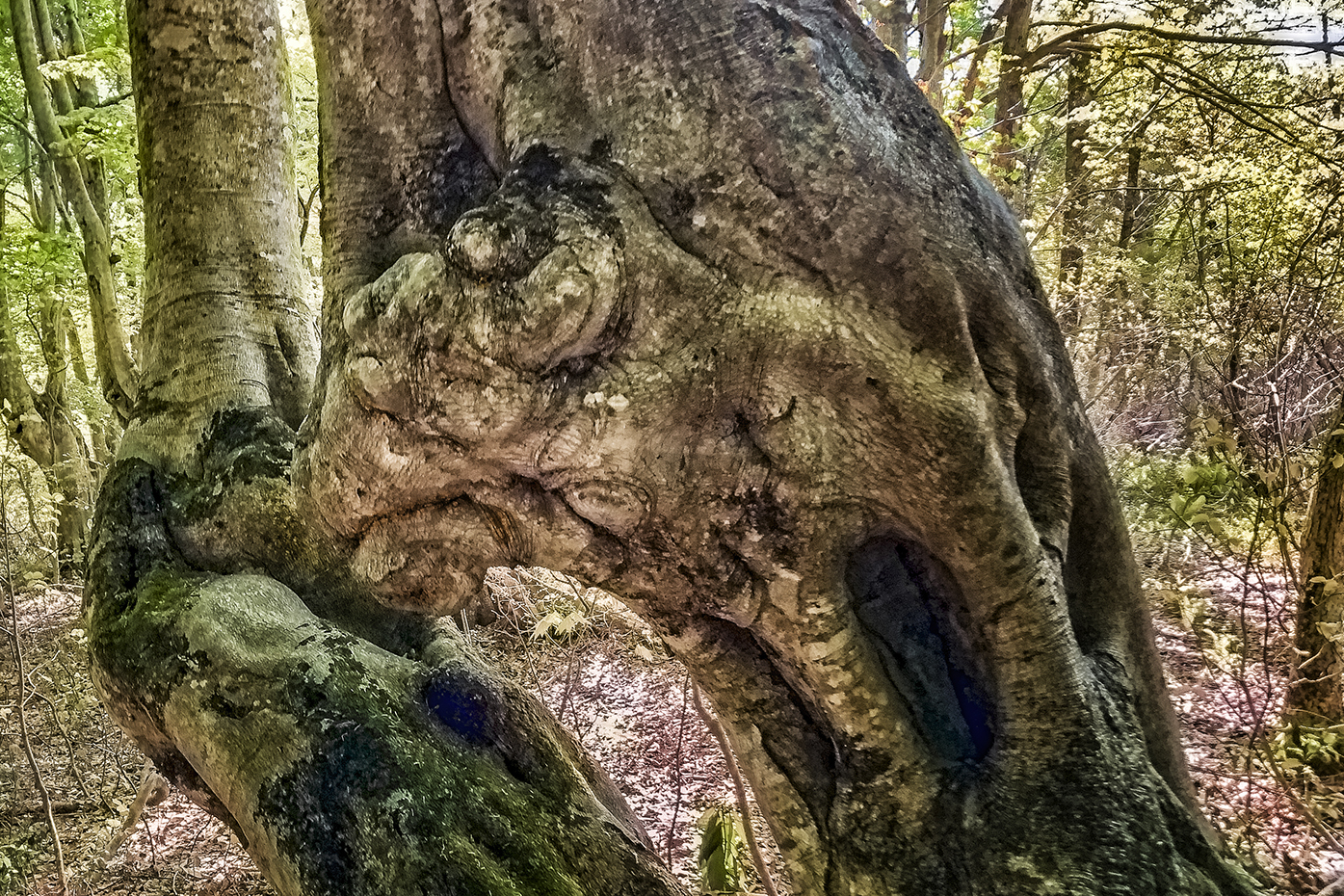
- How is it that I felt a difference in energy between the tree, the spirit of the tree, the kami of that tree, possibly multiple kami, and/or perhaps kodama as well?
Perhaps it is because there are indeed different life force energies. Or, perhaps the ‘difference’ in energies doesn’t actually matter, as the East Asian view of nature and human is a relationship of unity, and in Shintōism in particular, there is a tripartite relationship between kami, human beings and nature, without clear distinction. In fact, the Japanese did not have a word for ‘nature’ until they had contact with the West around 1900 when the European scientific culture entered Japan. The same is likely true for the indigenous Native Americans who it is said did not make a linguistic distinction between “the wilderness” and their home or all life. It is all a matter of difference in paradigm. Of course, today more than ever in the increasing expansive urban society of Japan, ‘nature’ is distinctive place where people go to for relaxation and healing, in such activities as forest bathing. However, from my research in that field, there is no acknowledgement in the science of Forest Medicine that the healing powers of forest bathing has anything to do with the sacred energies of shinboku trees or kami or the sacred forests.
- If the kami can come and go as they please, will the kami permanently leave the earthly realm if no one worships them or if their homes in nature (such as trees and forests) are carelessly destroyed? How would that affect our human world and the functioning of the planet itself? I have been told by the ancestors that it is the rituals of the indigenous peoples that ‘keeps the Earth spinning’. How has our human world been affected so far by forgotten honored spirits and worshipped divinities?
Japan’s 30,000-plus years of continual habitation and probable worshipping of nature kami and shinboku certainly has created a palpable power ingrained in the landscape of Japan itself; it is woven into the psyche and collective unconscious of the Japanese. I cannot imagine it ever disappearing from the islands of Japan, even with the juxtaposition of modern culture, which hiddenly embraces animism in its kawaii culture of cuteness of manufactured objects and imagery that knows no boundaries.
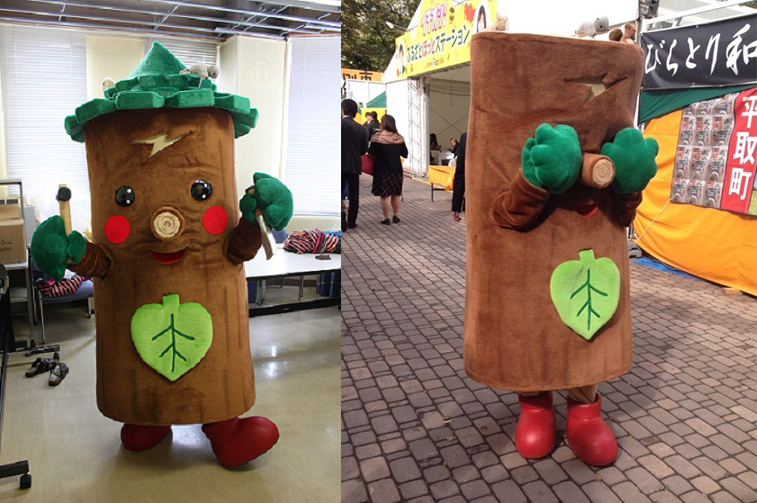
The tree mascot character (yuru-chara) of a small town. Photo Credit:unknown
However, I do believe that if the spiritual and divine aspects of life on Earth become extinct, so will humans. Indeed, we now live in a crisis period in history where the sacred is being purposely replaced by the false religion of technology by the fascist priests of the global corporate technocracy. Just as in ecopsychology, the goal being to help remind people that we are nature, I believe that reviving the honoring and worshipping of the kamigami of the natural world, as well as other ancient deities, helps us to reclaim our naturally divine relationship with the invisible dimension of the more-than-human world. This revived relationship may be the key to save both humanity and the planet.
This “phenomenality,” as I call it, of Shintō sacred trees (shinboku) is a true sacred and mysterious phenomenon of the confluence and union of nature, culture, and spirit. On my expedition to Japan, I met dozens of trees and species, but I seemed to have unexpectedly fallen in awe with the Hiba, Japanese Red Cedar, Katsura, and Camphor. These encounters will forever be a part of me and strengthen my connection with the more-than-human world. Was photographing myself being naked in their arms a necessary part of the phenomenonality? No, it was most certainly simply being in the presence of their divine energy. But dialoging with the kami of the shinboku trees led me deeper into their world. The greatest gift, beyond good photographs, however, was receiving a good kick of humility to my TreeGirl ego; after twenty-five years, I thought I had the whole tree-connection process down, but, fortunately, there is always more to humility, learning and healing available from the infinity mystery of spirit and nature.
Note: You can see some of my encounters with these trees and my Japan expedition in this video entitled “TreeGirl in Japan”: https://www.treegirl.org/treegirl-travel-videos.html
All photos © Julianne Skai Arbor/TreeGirl Studios, except where noted.
______________________________________________________________________
FOOTNOTES
[1] Note: sometimes you will see Kami capitalized, and other times, not; sometimes you will read kami as italicized, and sometimes not. For the purposes of this article, kami will not be capitalized but will be in italics, along with other important Japanese Shintō terms, for easier reading.
[2] See article, Worldwide Kami, Global Shinto: the Invention and Spread of a Nature Religion.
[3] Kami have been characterized in the Japanese animation arts; Hayao Miyazaki’s popular film Totoro is one such popular magical and lovable kami of the forest whom in the film, only children can see. In fact, Miyazaki’s Studio Ghibli has been likened to embody a modern kami itself, responsible for keeping the values of Shinto and the nature kami alive in the hearts and psyches of modern industrialized youth and adults alike.
[4] See Richard A. Gardner “Takasago: The Symbolism of the Pine” p.219
[5] Zach Davisson– “Ki no Kami – The God in the Tree” – https://hyakumonogatari.com/2012/07/18/ki-no-kami-the-god-in-the-tree/
[6] Tracing Shintoism in Japanese Nature-based Domestic Tourism Experiences
[7] See Zack Davisson “Translated Japanese Ghost Stories and Tales of the Weird and the Strange”. https://hyakumonogatari.com/2012/07/01/moidon-the-lords-of-the-forest/
[8] Kodama, like kami, have also been given a variety of characteristic appearance in the Japanese manga and films such as Miyazaki’s animations.
BIBLIOGRAPHY
Cali, Joseph and John Dougill. Shinto Shrines: A Guide to the Sacred Sites of Japan’s Ancient Religion. Honolulu: University of Hawaii Press, 2013.
Carbullido, Sherri. “Spirituality, Aesthetics, and Aware: Feeling Shinto in Miyazaki Hayao’s My Neighbour Totoro.” MA Thesis, University of Victoria. 2013.
Carter, Caleb. “Power Spots and the Charged Landscape of Shinto.” Japanese Journal of Religious Studies 45, no. 1 (2018): 145-74. Accessed March 29, 2020. doi: 10.2307/26854474.
Davisson, Zack. “Kodama – The Tree Spirit”. Hyakumonogatari Kaidankai: Translated Japanese Ghost Stories and Tales of the Weird and the Strange.” https://hyakumonogatari.com/2012/08/05/kodama-the-tree-spirit/ Accessed: January 9, 2018.
Davisson, Zack. “Moidon–the Lords of the Forest”. Hyakumonogatari Kaidankai: Translated Japanese Ghost Stories and Tales of the Weird and the Strange. https://hyakumonogatari.com/2012/07/01/moidon-the-lords-of-the-forest/ Accessed: June 25, 2021.
Davisson, Zack. “Ki No Kami the god in the Tree”. Hyakumonogatari Kaidankai: Translated Japanese Ghost Stories and Tales of the Weird and the Strange.” https://hyakumonogatari.com/2012/07/18/ki-no-kami-the-god-in-the-tree/ Accessed: June 25, 2021.
Gardner, Richard A. “Takasago: The Symbolism of the Pine.” Monumenta Nipponica 47, no. 2 (1992): 203-40. Accessed: March 23, 2020. doi:10.2307/2385237.
Hara, Kazuya. “Aspects of Shinto in Japanese Communication.” (2003). Intercultural Communication Studies XXI-4 2003. Accessed: March 24, 2020.https://web.uri.edu/iaics/files/05-Kazuya-Hara.pdf
Hiroshi Takahashi, video interviewed by author. Shinrinkan Forest Museum, Okutama, Japan May 23, 2019.
Hosoi, Y. T. “The Sacred Tree in Japanese Prehistory.” History of Religions 16, no. 2 (1976): 95-119. Accessed March 25, 2020. www.jstor.org/stable/1062238.
Kincaid, Christopher. Under the Cherry Blossoms: An Introduction to Japanese Tree Folklore. Kitsune Publishing, 2017. Kindle edition.
KYUSHU X TOKYO. “Giant Camphor Tree of Takeo (Takeo no Okusu)”. Accessed: August 28, 2018. https://www.kyushuandtokyo.org/spot_47/
“Giant Camphor Tree of Takeo (Takeo no Okusu)”. Accessed: August 28, 2018. https://www.kyushuandtokyo.org/spot_47/.
Omura, Hiroshi. “Trees, Forests and Religion in Japan”. International Mountain Society Mountain Research and Development 24, no. 2 (May 2004): 179-182. URL: https://doi.org/10.1659/0276-4741(2004)024[0179:TFARIJ] 2.0.CO; 2.
Rots, Aike P. “Worldwide Kami, Global Shinto: The Invention and Spread of a “Nature Religion”. (2016).
“Shintoism and Ecology”. Accessed March 25, 2020. http://environment-ecology.com/religion-and-ecology/510-shintoism-and-ecology.html.
Takahashi, Hiroshi. 千年の人生:古代の木への巡礼 Sennen no inochi: Kyoju, kyoboku o meguru [A Thousand Years of Life: A Pilgrimage to Ancient Trees]. Tōkyō: Shin-Nippon Publishing, 2016.
Takahashi, Hiroshi. Spring Immemorial Ancient Trees in a New Season of Green. Accessed: August 12, 2018. https://www.nippon.com/en/views/b05311/spring-immemorial-ancient-trees-in-a-new-season-of-green.html.
Yamakage, Motohisa. The Essence of Shinto: Japan’s Spiritual Heart. Tokyo: Kodansha International, Ltd. 2006.
“Yauki-gakio &Yuki-tsuri”. Accessed March 28, 2020. https://www.japanvisitor.com/about-japan/yuki-tsuri.
Young-Sook Lee, Seiichi Sakuno, Nina Prebensen and Kazuhiko Kimura. Tracing Shintoism in Japanese Nature-based Domestic Tourism Experiences. Cogent Social Sciences (2018), 4: 1446671. Accessed: March 24, 2020. https://doi.org/10.1080/233311886.2018.1446671











